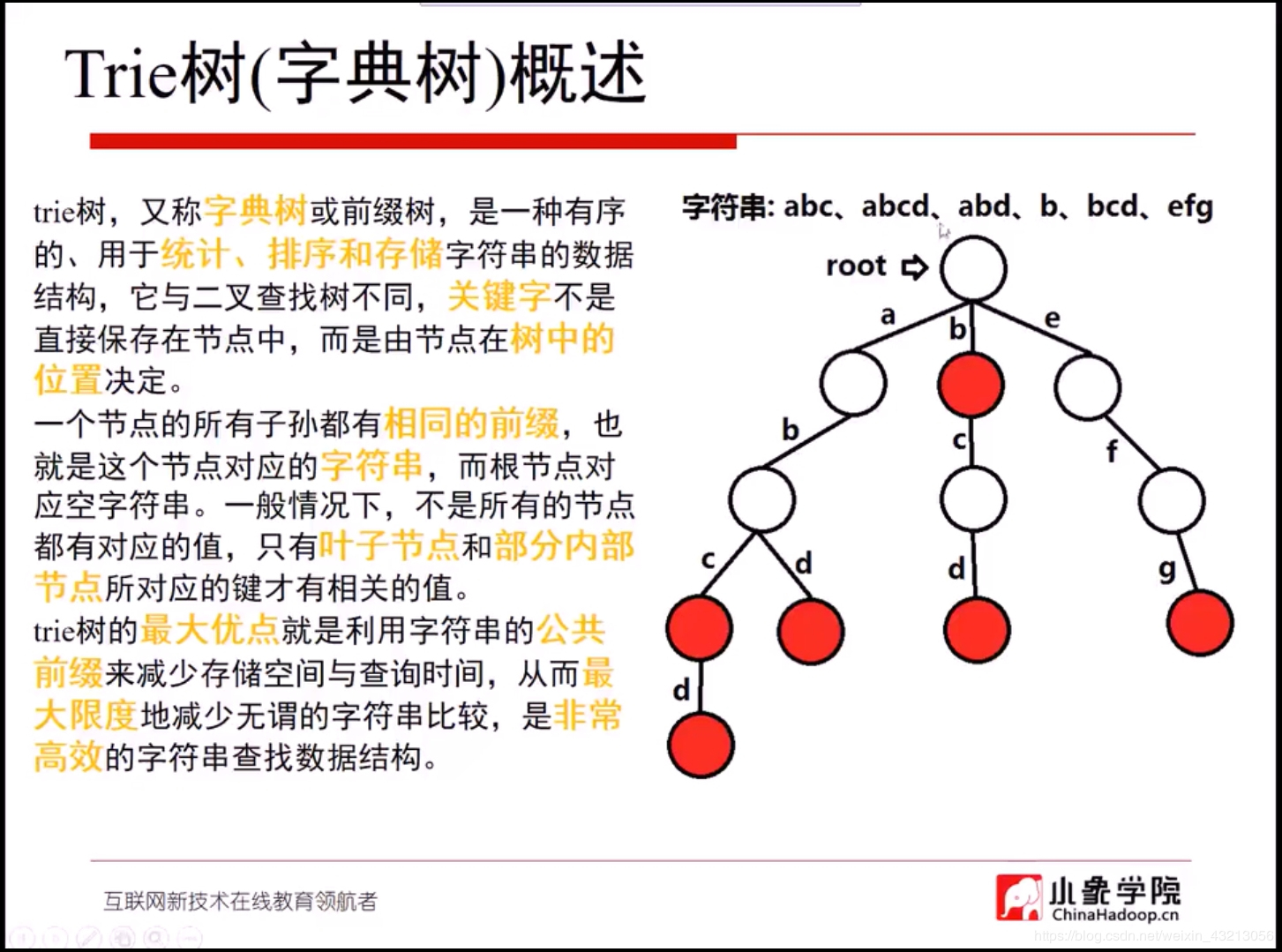
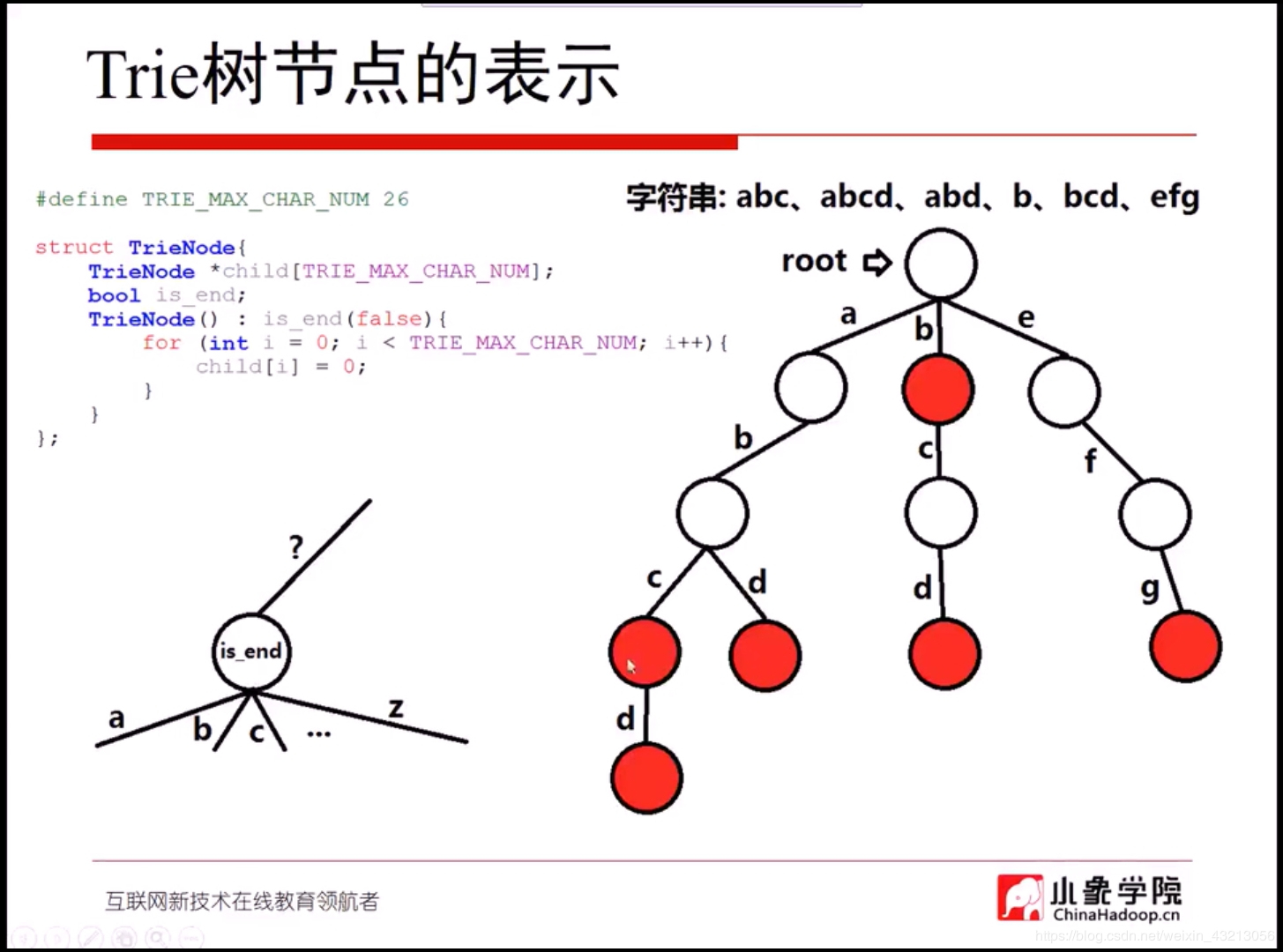
//Trie 树节点表示(字典树)
#include <stdio.h>
# define TRIE_MAX_CHAR_NUM 26
struct TrieNode {
TrieNode* child[TRIE_MAX_CHAR_NUM]; // Trie 树的指针数组
bool is_end;
TrieNode() : is_end(false) {
for (int i = 0; i < TRIE_MAX_CHAR_NUM; i++) {
child[i] = 0;
}
}
};
void preorder_trie(TrieNode* node, int layer) { // Trie树的前序遍历
for (int i = 0; i < TRIE_MAX_CHAR_NUM; i++) {
if (node->child[i]) {
for (int j = 0; j < layer; j++) {
printf("---");
}
printf("%c", i + 'a');
if (node->child[i]->is_end) {
printf("(end)");
}
printf("\n");
preorder_trie(node->child[i], layer + 1);
}
}
}
int main() {
TrieNode root;
TrieNode n1;
TrieNode n2;
TrieNode n3;
root.child['a' - 'a'] = &n1;
root.child['b' - 'a'] = &n2;
root.child['e' - 'a'] = &n3;
n2.is_end = true;
TrieNode n4;
TrieNode n5;
TrieNode n6;
n1.child['b' - 'a'] = &n4;
n2.child['c' - 'a'] = &n5;
n3.child['f' - 'a'] = &n6;
TrieNode n7;
TrieNode n8;
TrieNode n9;
TrieNode n10;
n4.child['c' - 'a'] = &n7;
n4.child['d' - 'a'] = &n8;
n5.child['d' - 'a'] = &n9;
n6.child['g' - 'a'] = &n10;
n7.is_end = true;
n8.is_end = true;
n9.is_end = true;
n10.is_end = true;
TrieNode n11;
n7.child['d' - 'a'] = &n11;
n11.is_end = true;
preorder_trie(&root, 0); // 字典树的前序遍历
return 0;
}
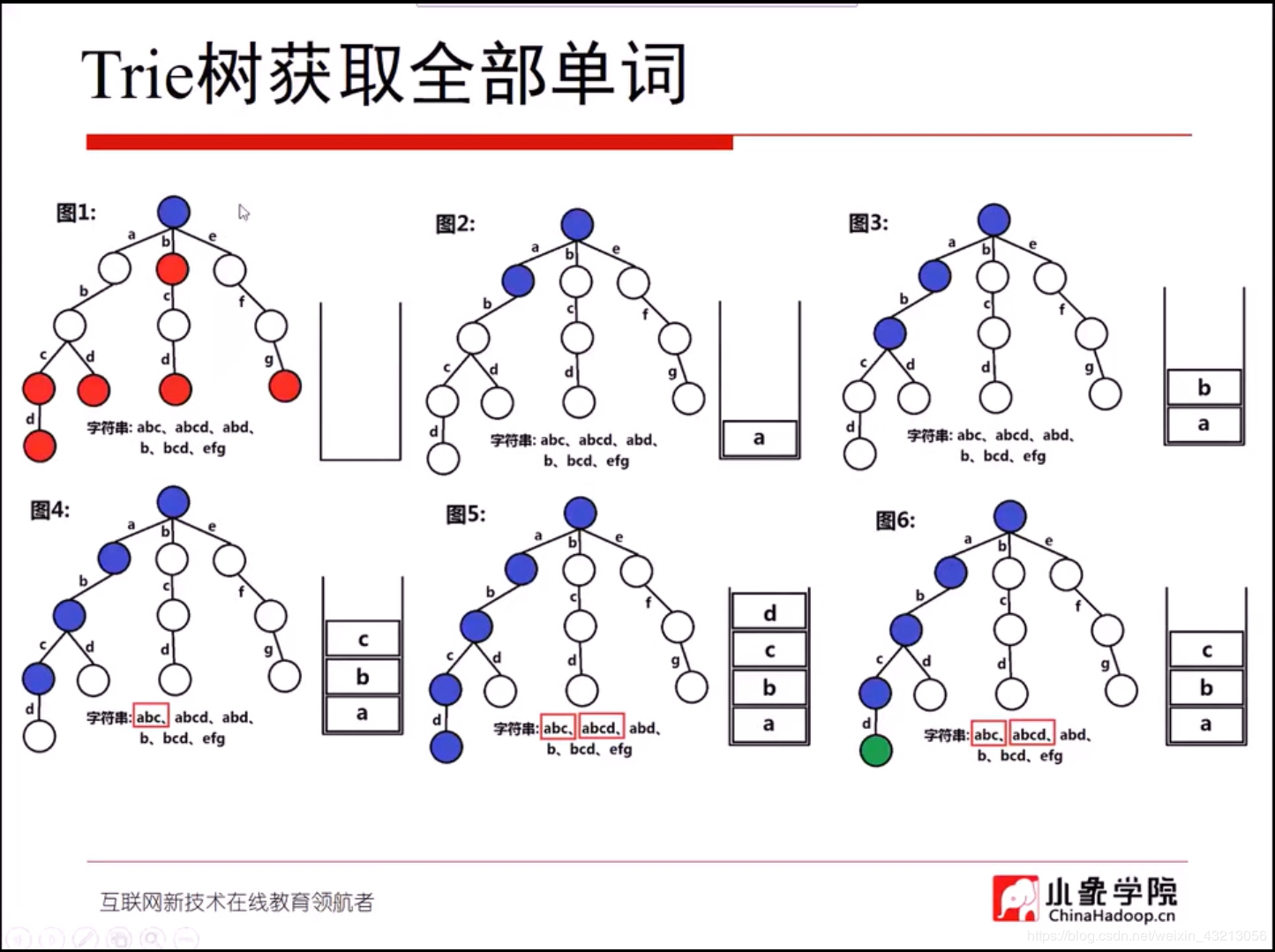
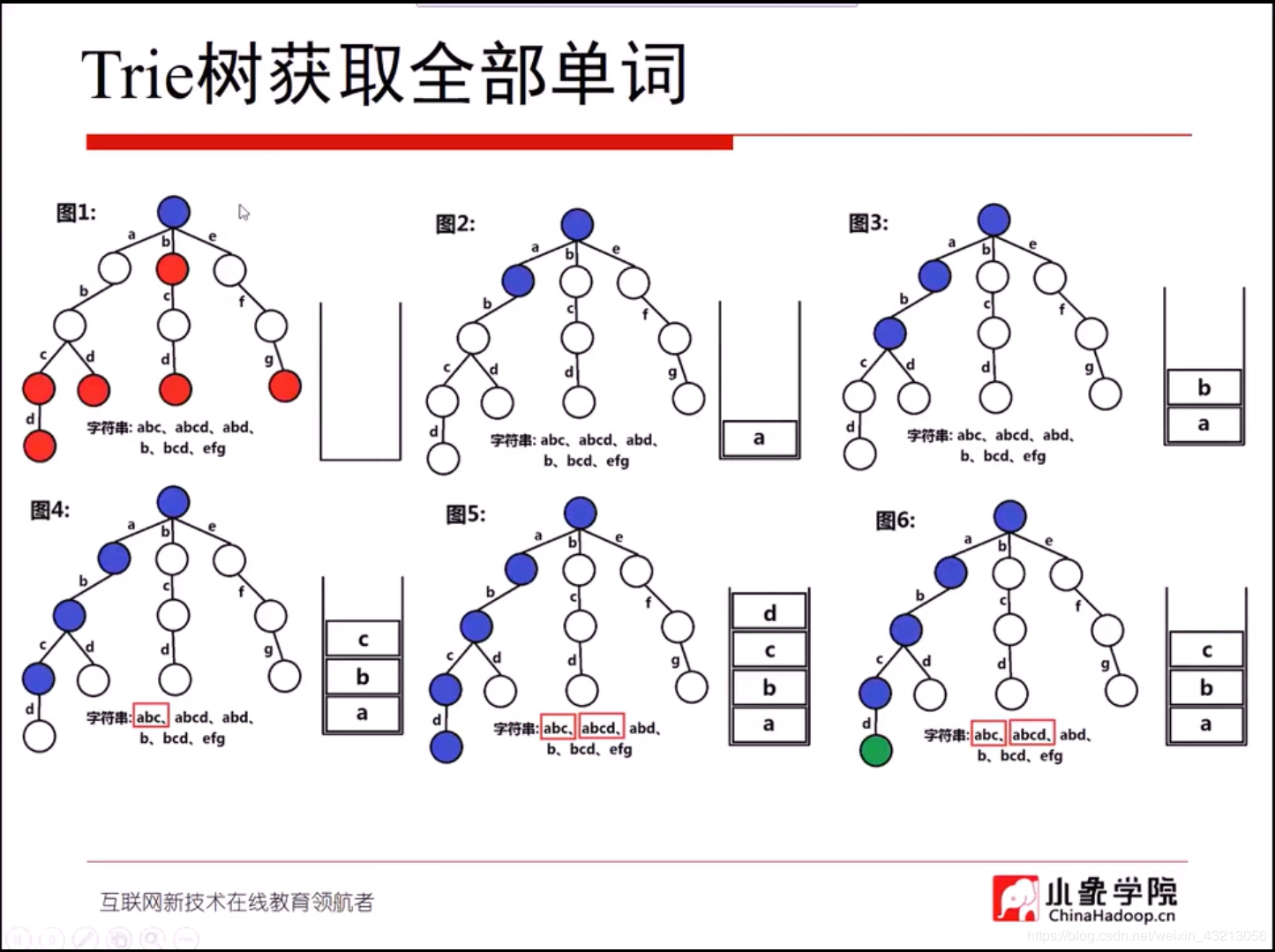
// Trie 树获取全部单词
#include <stdio.h>
#include <string>
#include <vector>
#define TIRE_MAX_CHAR_NUM 26
struct TrieNode {
TrieNode* child[TIRE_MAX_CHAR_NUM];
bool is_end;
TrieNode() : is_end(false) {
for (int i = 0; i < TIRE_MAX_CHAR_NUM; i++) {
child[i] = 0;
}
}
};
void get_all_word_from_trie(TrieNode* node, std::string word, std::vector<std::string>& word_list) {
for (int i = 0; i < TIRE_MAX_CHAR_NUM; i++) {
if (node->child[i]) {
word.push_back(i + 'a'); // string也可以用push_back
if (node->child[i]->is_end) {
word_list.push_back(word);
}
get_all_word_from_trie(node->child[i], word, word_list);
word.erase(word.length() - 1, 1); // 弹出最后一个字符
}
}
}
int main() {
TrieNode root;
TrieNode n1;
TrieNode n2;
TrieNode n3;
root.child['a' - 'a'] = &n1;
root.child['b' - 'a'] = &n2;
root.child['e' - 'a'] = &n3;
n2.is_end = true;
TrieNode n4;
TrieNode n5;
TrieNode n6;
n1.child['b' - 'a'] = &n4;
n2.child['c' - 'a'] = &n5;
n3.child['f' - 'a'] = &n6;
TrieNode n7;
TrieNode n8;
TrieNode n9;
TrieNode n10;
n4.child['c' - 'a'] = &n7;
n4.child['d' - 'a'] = &n8;
n5.child['d' - 'a'] = &n9;
n6.child['g' - 'a'] = &n10;
n7.is_end = true;
n8.is_end = true;
n9.is_end = true;
n10.is_end = true;
TrieNode n11;
n7.child['d' - 'a'] = &n11;
n11.is_end = true;
std::vector<std::string> word_list;
std::string word;
get_all_word_from_trie(&root, word, word_list); // root 要加' & '
for (int i = 0; i < word_list.size(); i++) {
printf("%s\n", word_list[i].c_str());
}
return 0;
}
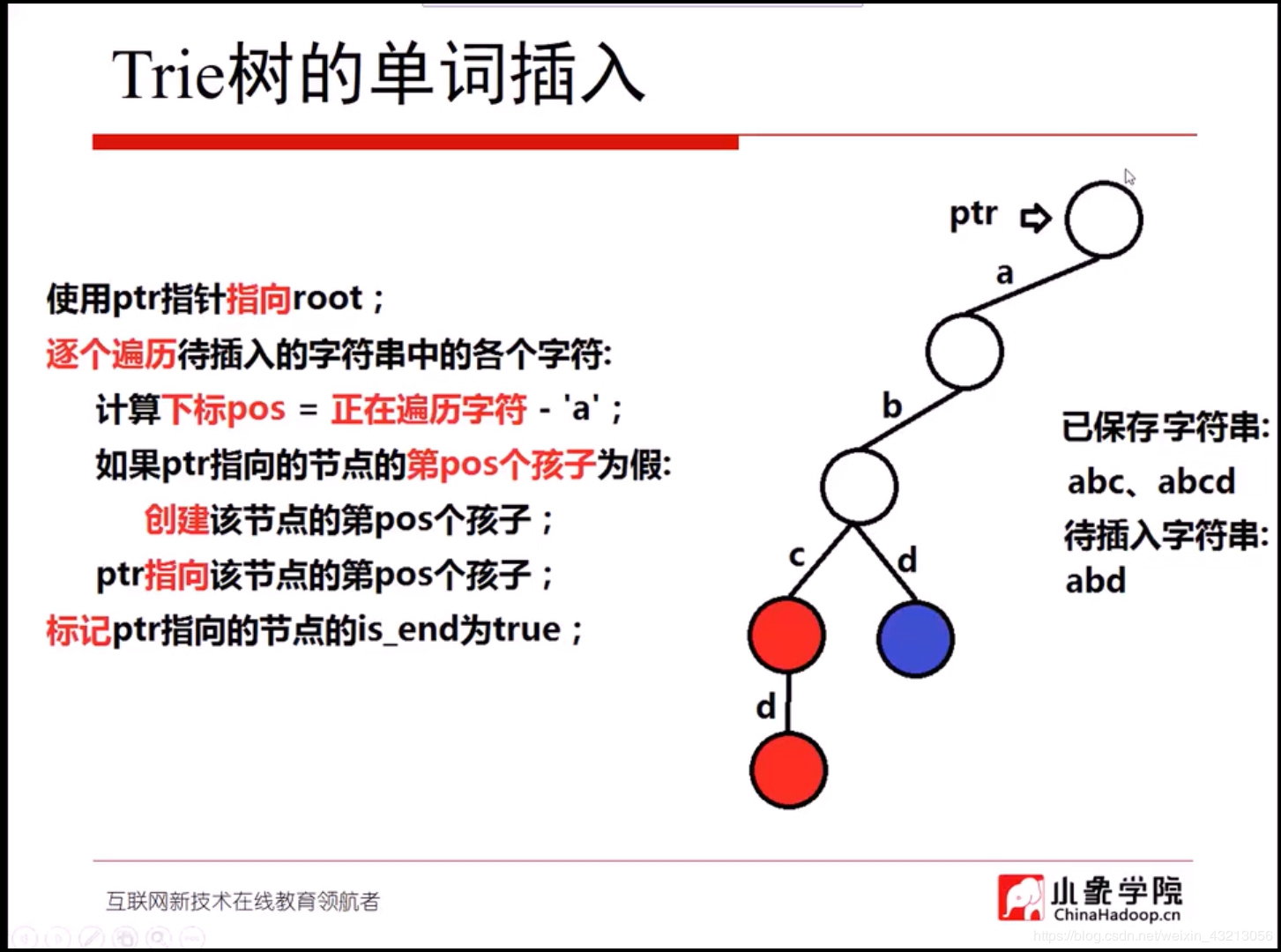
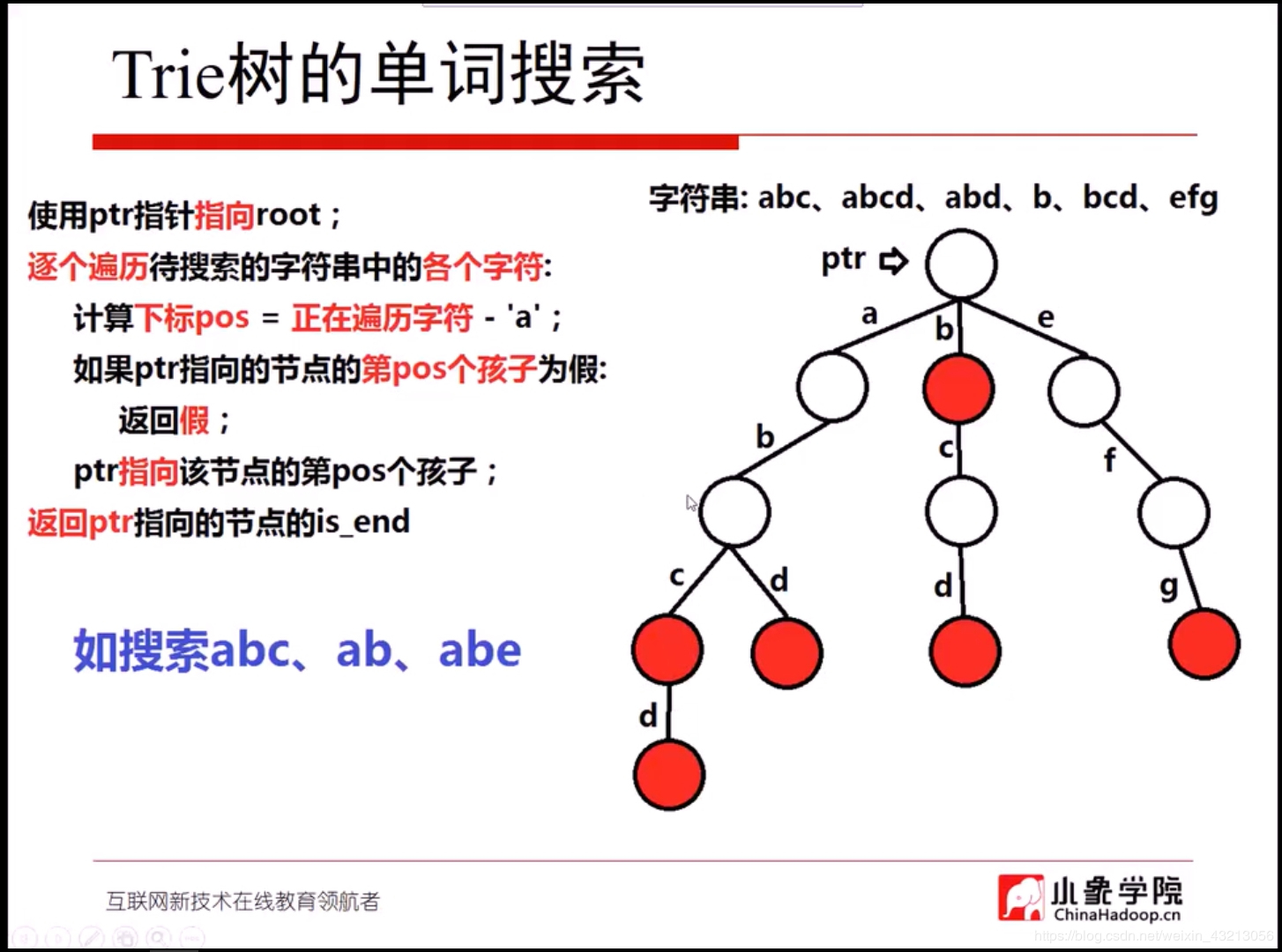
// Trie 树的整体功能 1. 将word插入trie 2. 搜索trie中是否存在word 3. 确认trie中是否有前缀为prefix的单词
#include <stdio.h>
#include <vector>
#include <string>
#define TRIE_MAX_CHAR_NUM 26
struct TrieNode {
TrieNode* child[TRIE_MAX_CHAR_NUM];
bool is_end;
TrieNode() : is_end(false) {
for (int i = 0; i < TRIE_MAX_CHAR_NUM; i++) {
child[i] = 0;
}
}
};
class TrieTree {
public:
TrieTree() {}
~TrieTree() {
for (int i = 0; i < _node_vec.size(); i++) {
delete _node_vec[i];
}
}
void insert(const char* word) { // Trie 插入 word
TrieNode* ptr = &_root;
while (*word) {
int pos = *word - 'a';
if (!ptr->child[pos]) { // word 是地址,*word是地址里的内容
ptr->child[pos] = new_node();
}
ptr = ptr->child[pos];
word++;
}
ptr->is_end = true;
}
bool search(const char* word) { // Trie 树搜索 word
TrieNode* ptr = &_root;
while (*word) {
int pos = *word - 'a';
if (!ptr->child[pos]) {
return false;
}
ptr = ptr->child[pos];
word++;
}
return ptr->is_end;
}
bool startsWith(const char* prefix) { // Trie 树前缀查询
TrieNode* ptr = &_root;
while (*prefix) {
int pos = *prefix - 'a';
if (!ptr->child[pos]) {
return false;
}
ptr = ptr->child[pos];
prefix++;
}
return true;
}
TrieNode* root() {
return &_root;
}
private:
TrieNode* new_node() {
TrieNode* node = new TrieNode();
_node_vec.push_back(node);
return node;
}
std::vector<TrieNode*> _node_vec;
TrieNode _root;
};
void preorder_trie(TrieNode* node, int layer) { //Trie 树前序遍历
for (int i = 0; i < TRIE_MAX_CHAR_NUM; i++) {
if (node->child[i]) {
for (int j = 0; j < layer; j++) {
printf("---");
}
printf("%c", i + 'a');
if (node->child[i]->is_end) {
printf("(end)");
}
printf("\n");
preorder_trie(node->child[i], layer + 1);
}
}
}
void get_all_word_from_trie(TrieNode* node, std::string word, std::vector<std::string>& word_list) {
for (int i = 0; i < TRIE_MAX_CHAR_NUM; i++) {
if (node->child[i]) {
word.push_back(i + 'a'); // string也可以用push_back
if (node->child[i]->is_end) {
word_list.push_back(word);
}
get_all_word_from_trie(node->child[i], word, word_list);
word.erase(word.length() - 1, 1); // 弹出最后一个字符
}
}
}
int main() {
TrieTree trie_tree;
trie_tree.insert("abcd");
trie_tree.insert("abc");
trie_tree.insert("abd");
trie_tree.insert("b");
trie_tree.insert("bcd");
trie_tree.insert("efg");
printf("preorder_trie:\n");
preorder_trie(trie_tree.root(), 0);
printf("\n");
std::vector<std::string> word_list;
std::string word;
printf("All words:\n");
get_all_word_from_trie(trie_tree.root(), word, word_list);
for (int i = 0; i < word_list.size(); i++) {
printf("%s\n", word_list[i].c_str());
}
printf("\n");
printf("search:\n");
printf("abc: %d\n", trie_tree.search("abc"));
printf("abcd: %d\n", trie_tree.search("abcd"));
printf("bc: %d\n", trie_tree.search("bc"));
printf("b: %d\n", trie_tree.search("b"));
printf("\n");
printf("ab: %d\n", trie_tree.startsWith("ab"));
printf("abc: %d\n", trie_tree.startsWith("abc"));
printf("bc: %d\n", trie_tree.startsWith("bc"));
printf("fg: %d\n", trie_tree.startsWith("fg"));
return 0;
};
例一:LeetCode208
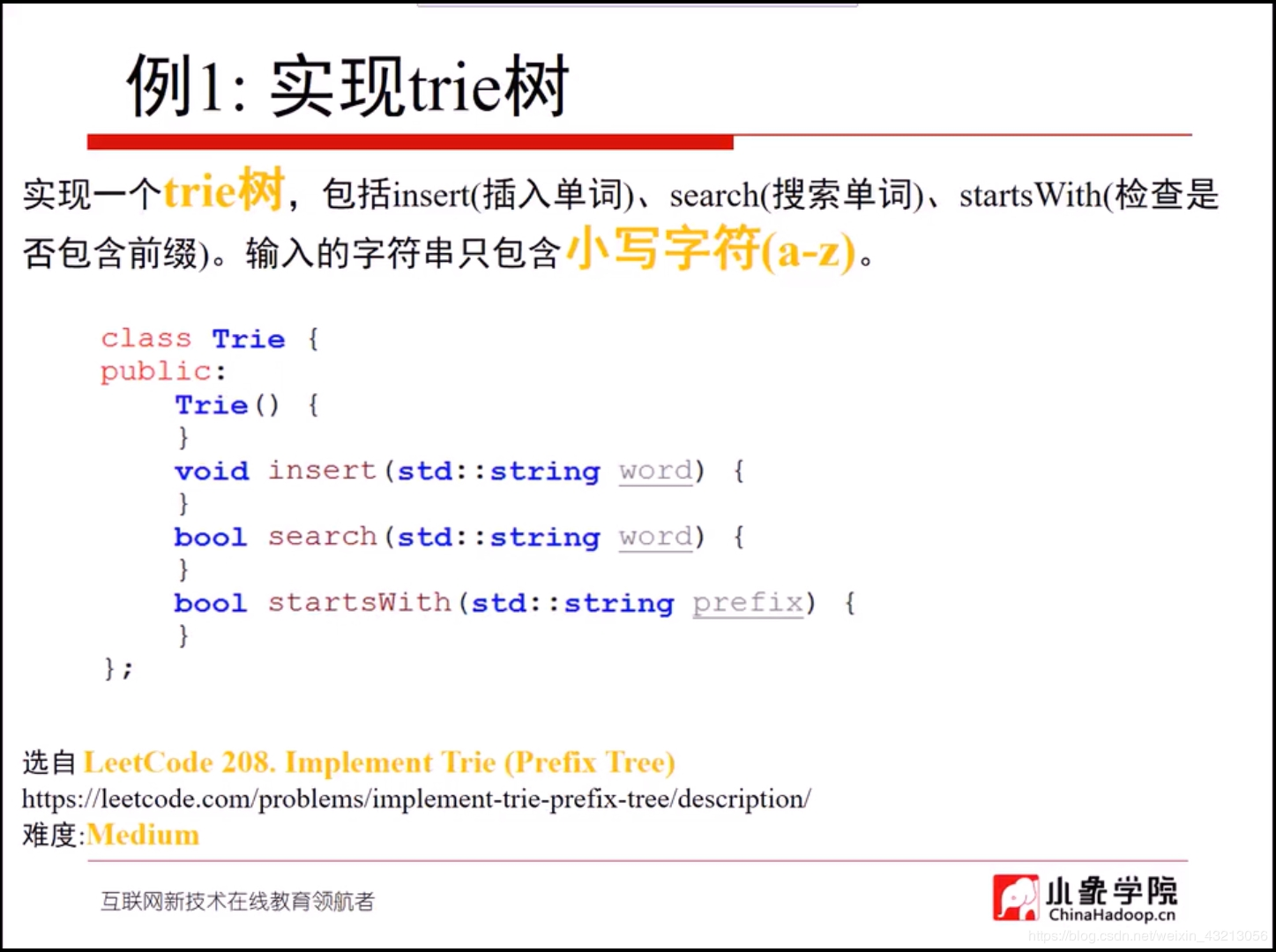
/**
Implement a trie with insert, search, and startsWith methods.
*/
#include <stdio.h>
#include <vector>
#include <string>
#define TRIE_MAX_CHAR_NUM 26
struct TrieNode {
TrieNode* child[TRIE_MAX_CHAR_NUM];
bool is_end;
TrieNode() : is_end(false) {
for (int i = 0; i < TRIE_MAX_CHAR_NUM; i++) {
child[i] = 0;
}
}
};
class TrieTree {
public:
TrieTree() {}
~TrieTree() {
for (int i = 0; i < _node_vec.size(); i++) {
delete _node_vec[i];
}
}
// 传入 const char * 最快,代表了string的首地址,或者 string &word也快
void insert(const char* word) { // Trie 插入 word
TrieNode* ptr = &_root;
while (*word) {
int pos = *word - 'a';
if (!ptr->child[pos]) { // word 是地址,*word是地址里的内容
ptr->child[pos] = new_node();
}
ptr = ptr->child[pos];
word++;
}
ptr->is_end = true;
}
bool search(const char* word) { // Trie 树搜索 word
TrieNode* ptr = &_root;
while (*word) {
int pos = *word - 'a';
if (!ptr->child[pos]) {
return false;
}
ptr = ptr->child[pos];
word++;
}
return ptr->is_end;
}
bool startsWith(const char* prefix) { // Trie 树前缀查询
TrieNode* ptr = &_root;
while (*prefix) {
int pos = *prefix - 'a';
if (!ptr->child[pos]) {
return false;
}
ptr = ptr->child[pos];
prefix++;
}
return true;
}
TrieNode* root() {
return &_root;
}
private:
TrieNode* new_node() {
TrieNode* node = new TrieNode();
_node_vec.push_back(node);
return node;
}
std::vector<TrieNode*> _node_vec;
TrieNode _root;
};
class Trie {
public:
Trie() {}
void insert(std::string word) {
_trie_tree.insert(word.c_str());
}
bool search(std::string word) {
return _trie_tree.search(word.c_str());
}
bool startsWith(std::string prefix) {
return _trie_tree.startsWith(prefix.c_str());
}
private:
TrieTree _trie_tree;
};
int main() {
Trie trie;
trie.insert("abcde");
printf("%d\n", trie.search("abcde"));
printf("%d\n", trie.startsWith("abc"));
printf("%d\n", trie.startsWith("abcdef"));
printf("%d\n", trie.startsWith("abcde"));
return 0;
}
例二:LeetCode211
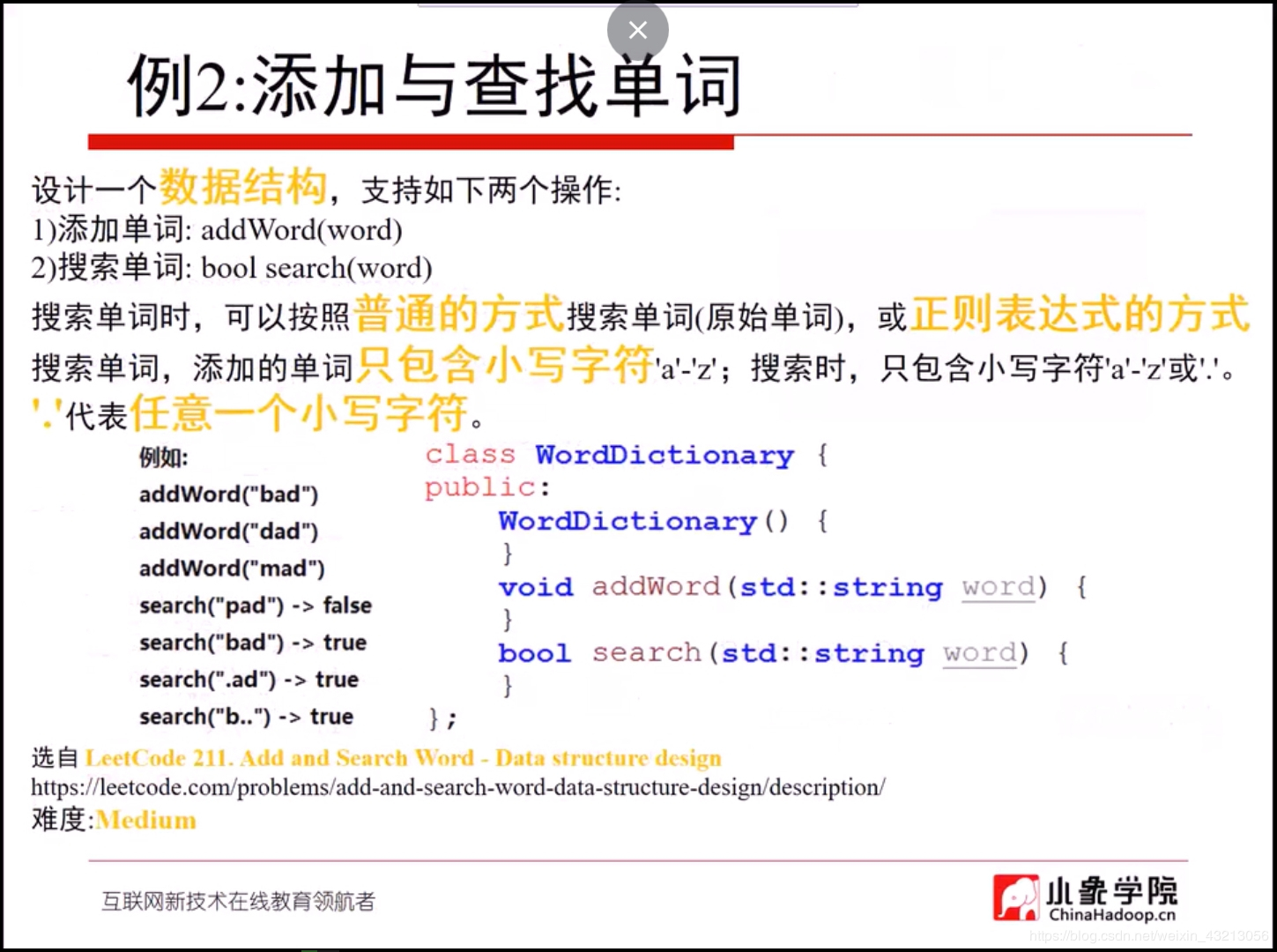
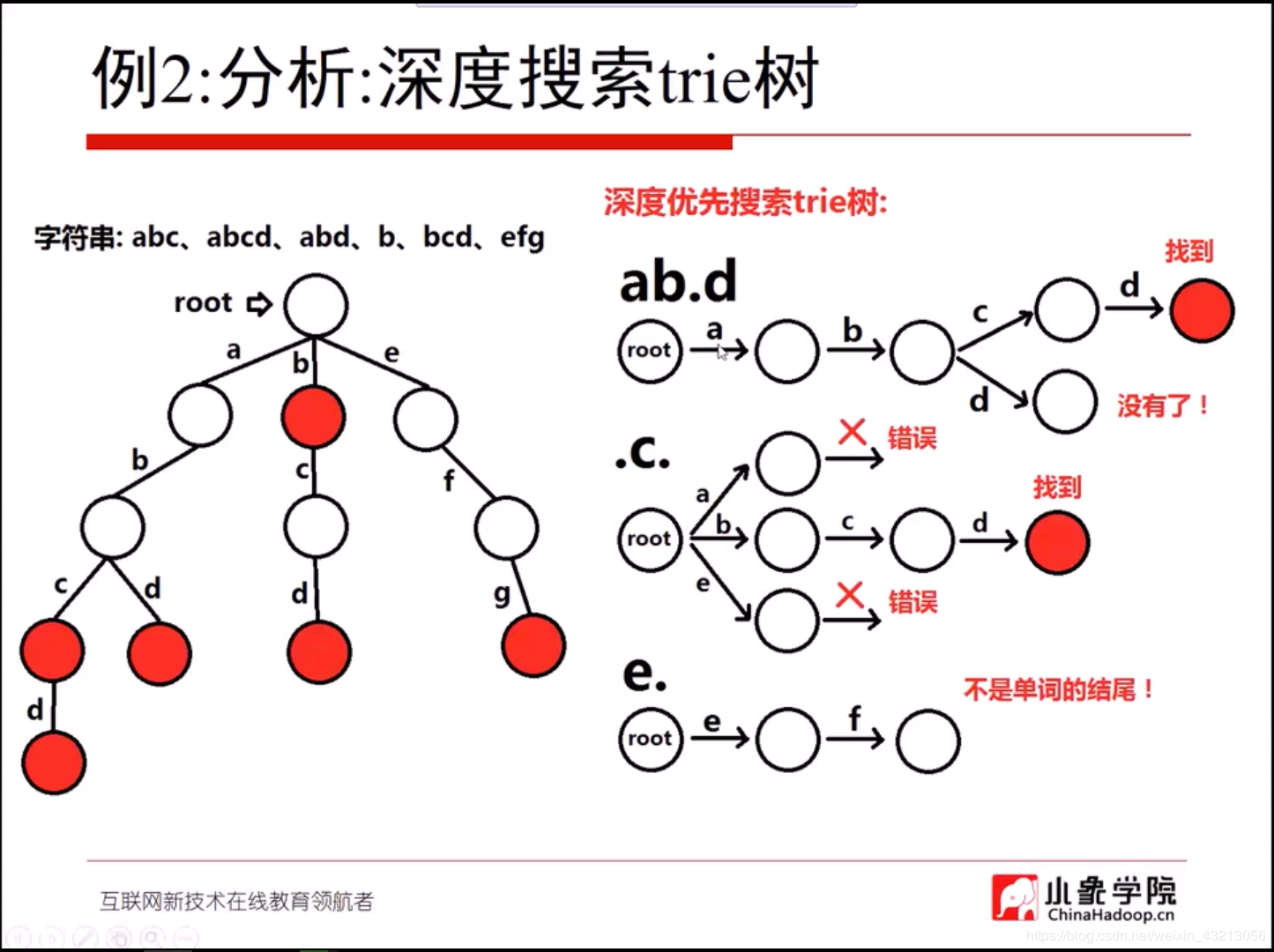
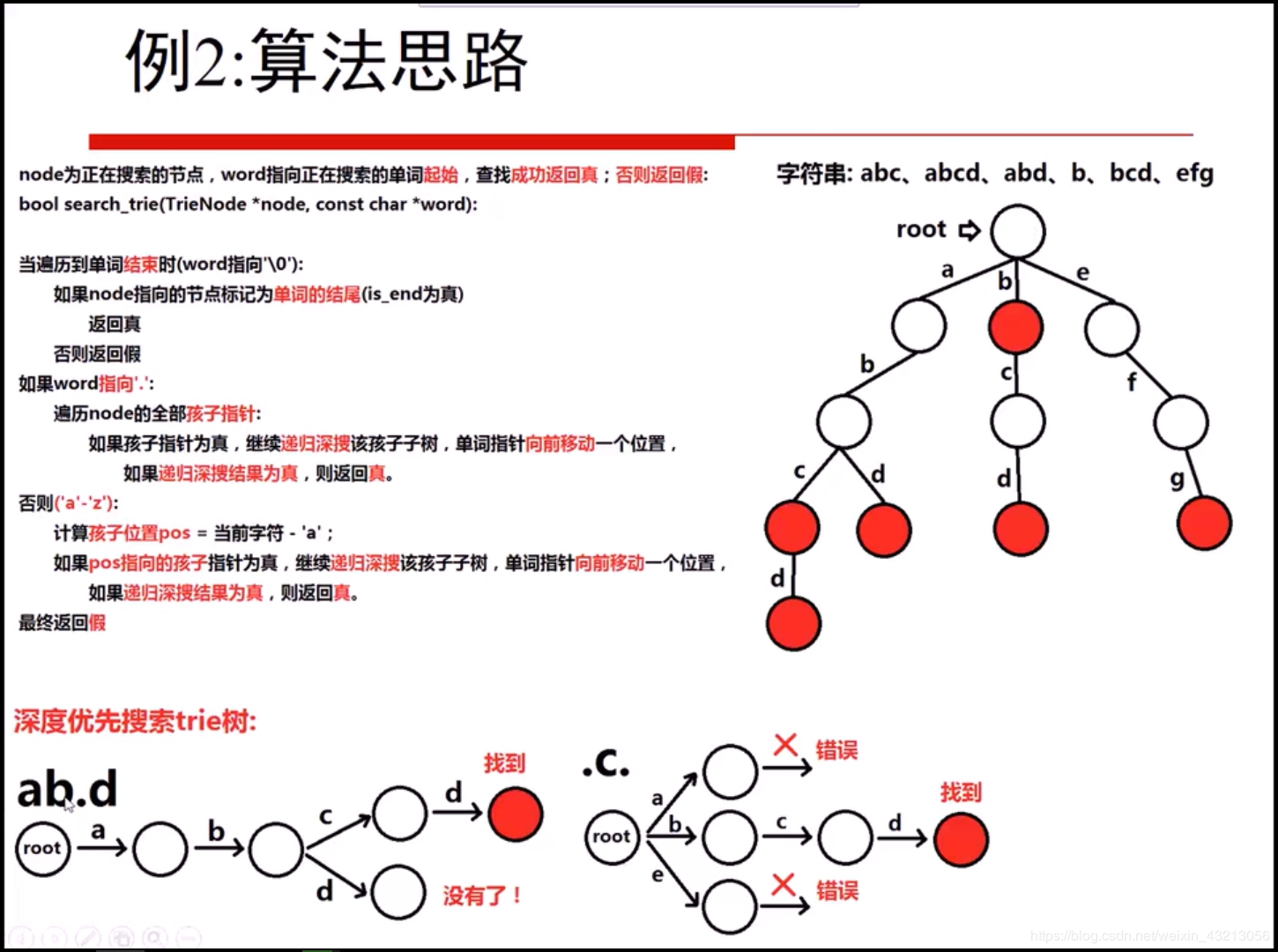
/**
Design a data structure that supports the following two operations:
void addWord(word)
bool search(word)
search(word) can search a literal word or a regular expression string
containing only letters a-z or .. A . means it can represent any one letter.
*/
#include <stdio.h>
#include <vector>
#include <string>
#define TRIE_MAX_CHAR_NUM 26
struct TrieNode {
TrieNode* child[TRIE_MAX_CHAR_NUM];
bool is_end;
TrieNode() : is_end(false) {
for (int i = 0; i < TRIE_MAX_CHAR_NUM; i++) {
child[i] = 0;
}
}
};
class TrieTree {
public:
TrieTree() {}
~TrieTree() {
for (int i = 0; i < _node_vec.size(); i++) {
delete _node_vec[i];
}
}
void insert(const char* word) { // Trie 插入 word
TrieNode* ptr = &_root;
while (*word) {
int pos = *word - 'a';
if (!ptr->child[pos]) { // word 是地址,*word是地址里的内容
ptr->child[pos] = new_node();
}
ptr = ptr->child[pos];
word++;
}
ptr->is_end = true;
}
bool search(const char* word) { // Trie 树搜索 word
TrieNode* ptr = &_root;
while (*word) {
int pos = *word - 'a';
if (!ptr->child[pos]) {
return false;
}
ptr = ptr->child[pos];
word++;
}
return ptr->is_end;
}
bool search_trie(TrieNode* node, const char* word) {
if (*word == '\0') {
if (node->is_end) {
return true;
}
return false;
}
if (*word == '.') {
for (int i = 0; i < TRIE_MAX_CHAR_NUM; i++) {
if (node->child[i] && search_trie(node->child[i], word + 1)) {
return true;
}
}
}
else {
int pos = *word - 'a';
if (node->child[pos] && search_trie(node->child[pos], word + 1)) {
return true;
}
}
return false;
}
bool startsWith(const char* prefix) { // Trie 树前缀查询
TrieNode* ptr = &_root;
while (*prefix) {
int pos = *prefix - 'a';
if (!ptr->child[pos]) {
return false;
}
ptr = ptr->child[pos];
prefix++;
}
return true;
}
TrieNode* root() {
return &_root;
}
private:
TrieNode* new_node() {
TrieNode* node = new TrieNode();
_node_vec.push_back(node);
return node;
}
std::vector<TrieNode*> _node_vec;
TrieNode _root;
};
class WordDictionary {
public:
WordDictionary() {}
void addWord(std::string word) {
_tire_tree.insert(word.c_str());
}
bool search(std::string word) {
return _tire_tree.search_trie(_tire_tree.root(), word.c_str()); // c_str() 返回的是字符串的首字符地址
}
private:
TrieTree _tire_tree;
};
int main() {
WordDictionary word_dictionary;
word_dictionary.addWord("abc");
word_dictionary.addWord("bad");
word_dictionary.addWord("mad");
printf("%d\n", word_dictionary.search("pad"));
printf("%d\n", word_dictionary.search("bad"));
printf("%d\n", word_dictionary.search(".ad"));
printf("%d\n", word_dictionary.search("b.."));
return 0;
}
例三:LeetCode547
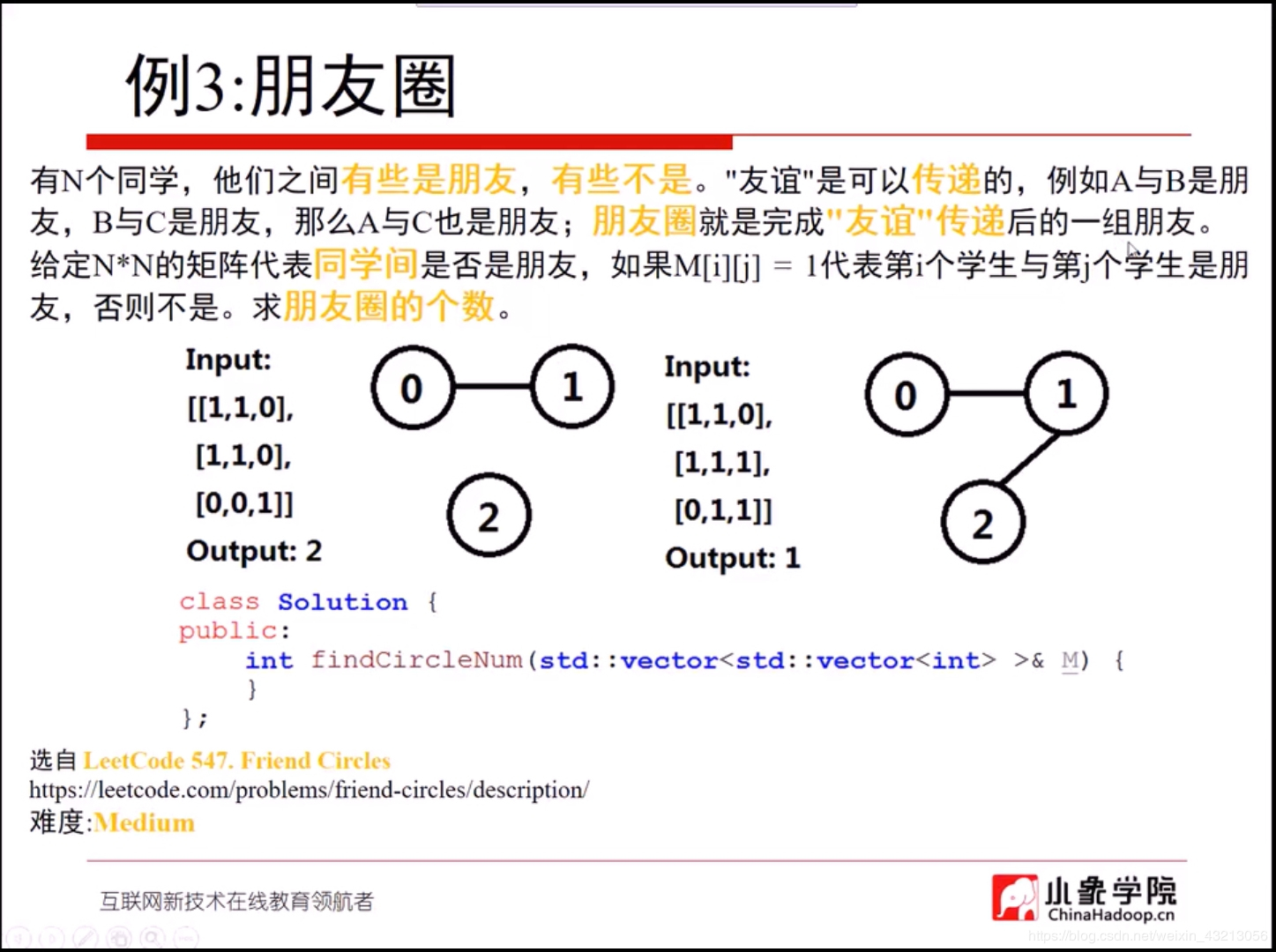
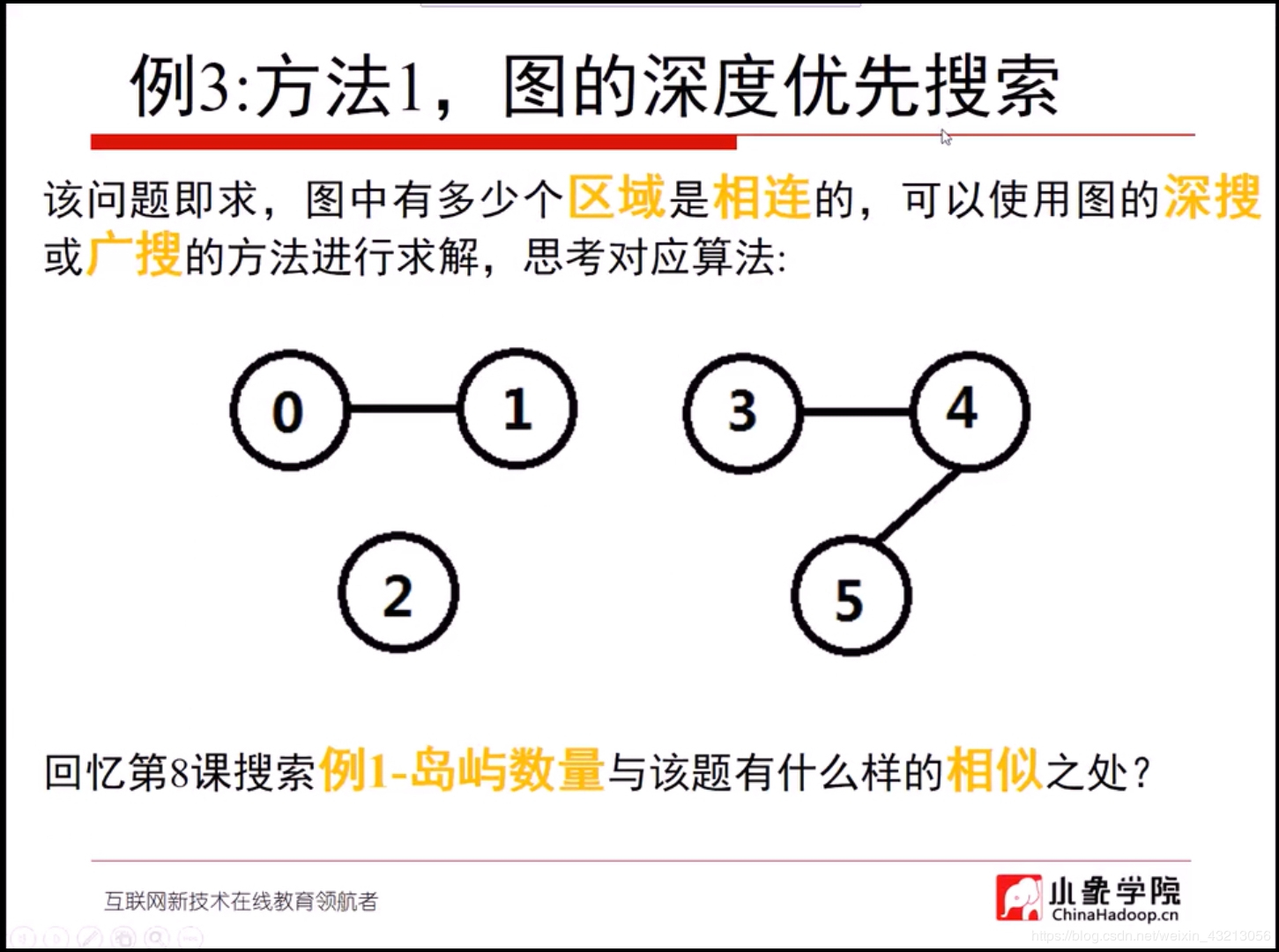
class Solution {
public:
int findCircleNum(std::vector<std::vector<int>>& M) {
std::vector<int> visit(M.size(), 0);
int count = 0;
for (int i = 0; i < M.size(); i++) {
if (visit[i] == 0) {
DFS_graph(i, M, visit);
count++;
}
}
return count;
}
private:
void DFS_graph(int u, std::vector<std::vector<int>>& graph, std::vector<int>& visit) {
visit[u] = 1;
for (int i = 0; i < graph[u].size(); i++) {
if (visit[i] == 0 && graph[u][i] == 1) {
DFS_graph(i, graph, visit);
}
}
}
};
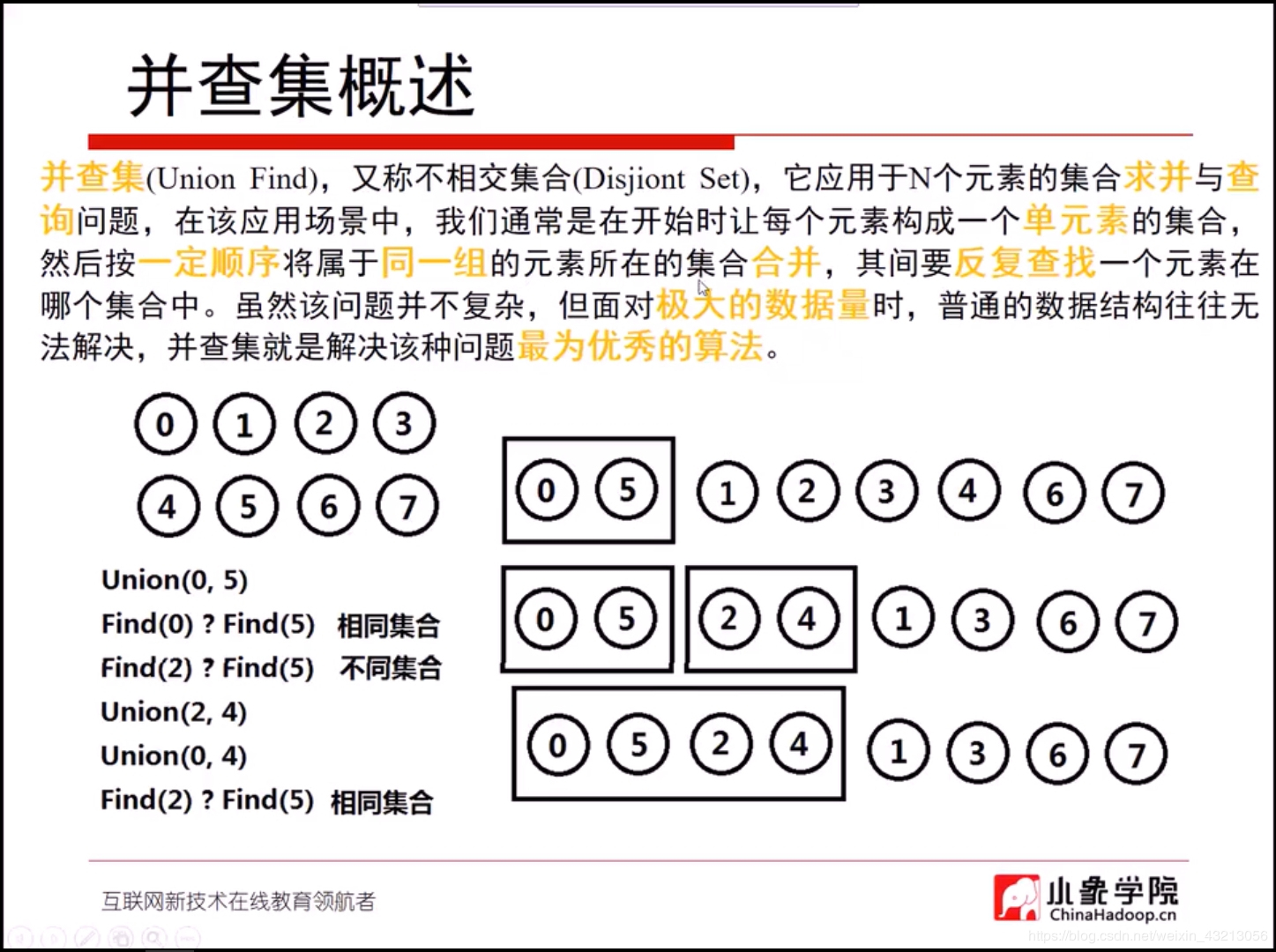
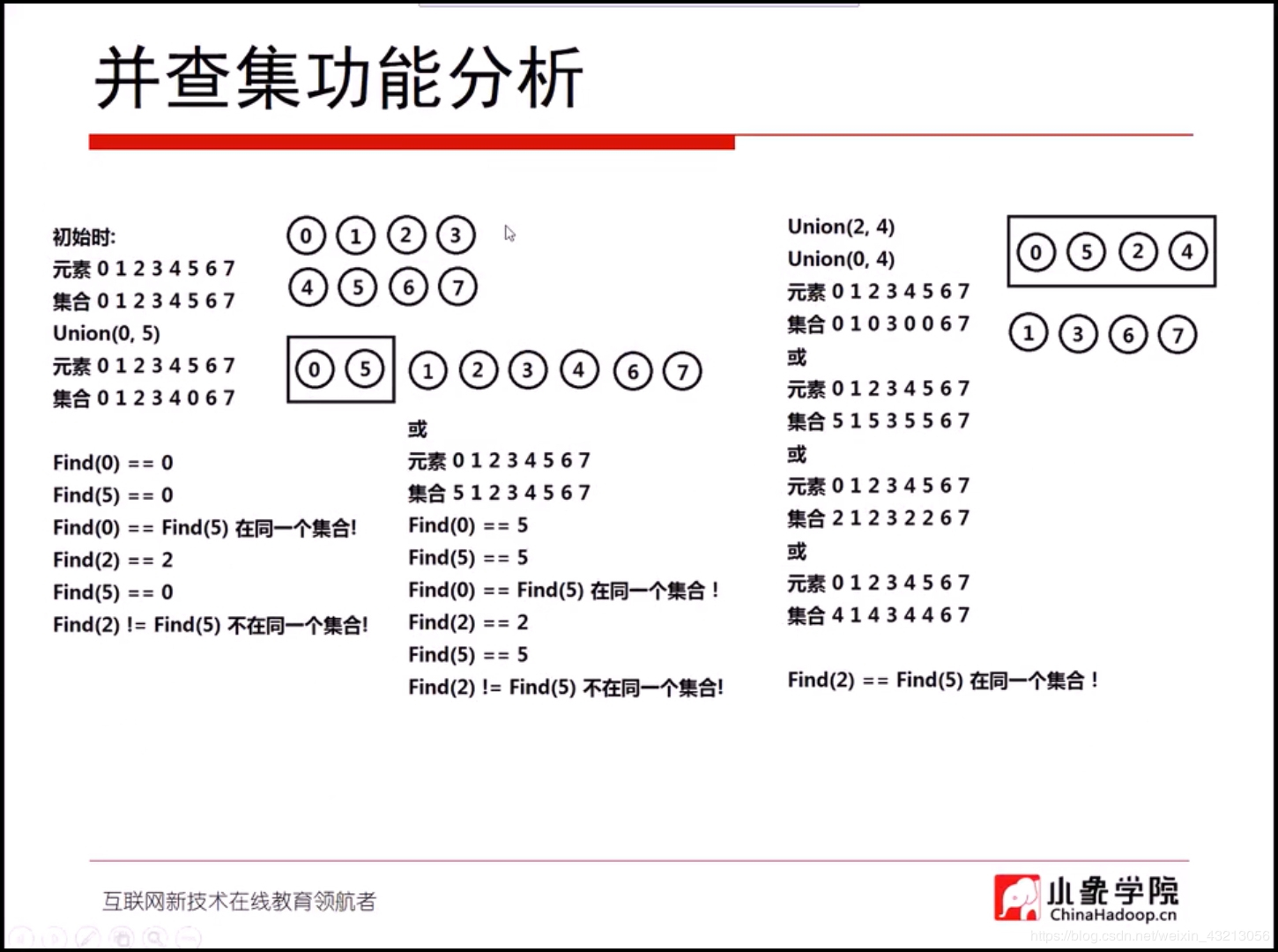
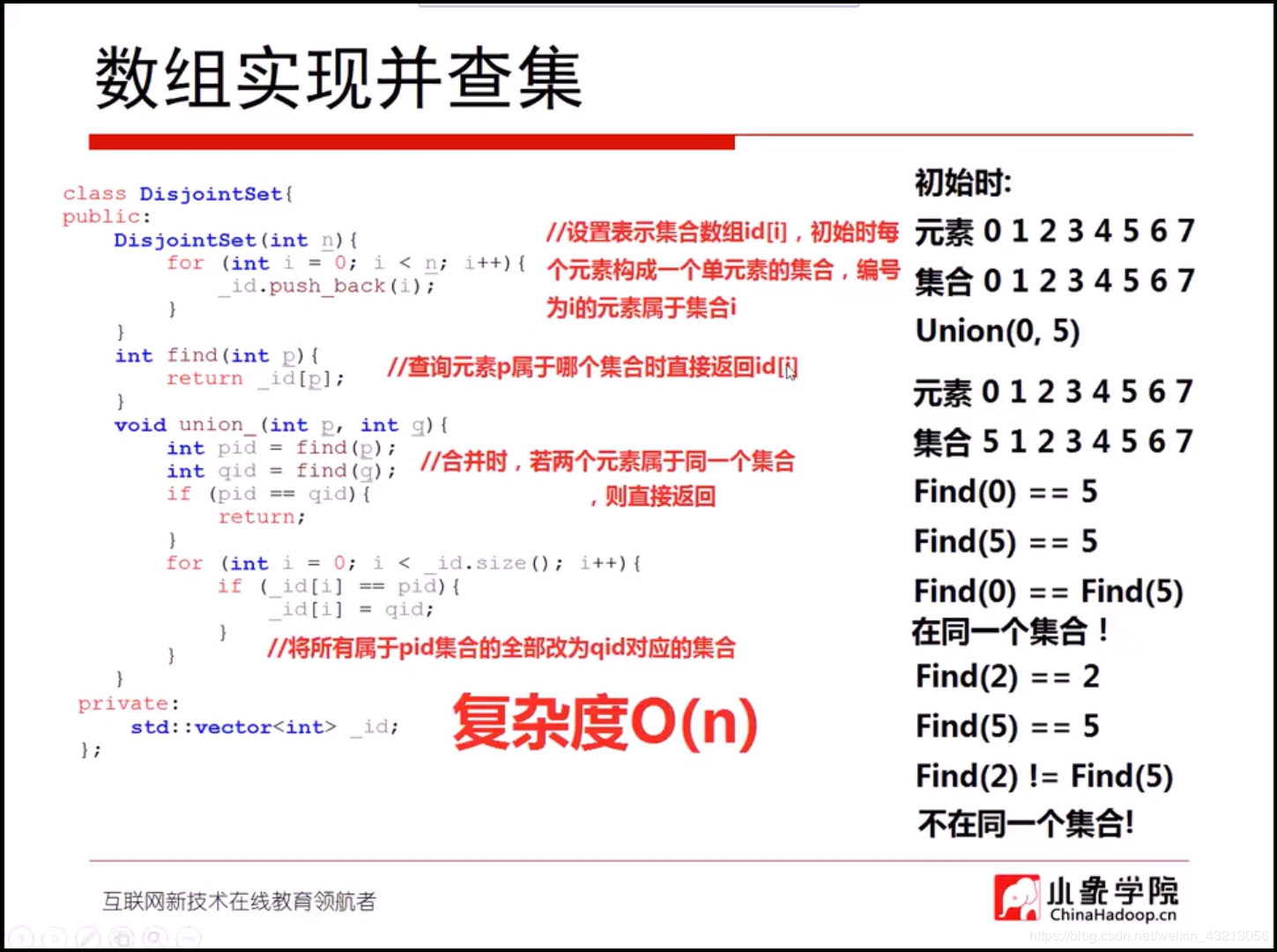
#include <stdio.h>
#include <vector>
#include <string>
// // 方法一:深度搜索算法
// class Solution{
// public:
// int findCircleNum(std::vector<std::vector<int>> &M){
// std::vector<int> visit(M.size(), 0);
// int count = 0;
// for(int i = 0; i < M.size(); i++){
// if(visit[i] == 0){
// DFS_graph(i, M, visit);
// count++;
// }
// }
// return count;
// }
// private:
// void DFS_graph(int u, std::vector<std::vector<int>> &graph, std::vector<int> &visit){
// visit[u] = 1;
// for(int i = 0; i < graph[u].size(); i++) {
// if (visit[i] == 0 && graph[u][i] == 1) {
// DFS_graph(i, graph, visit);
// }
// }
// }
// };
// 数组实现并查集
class DisjoinSet {
public:
DisjoinSet(int n) {
for (int i = 0; i < n; i++) {
_id.push_back(i);
}
}
int find(int p) {
return _id[p];
}
void union_(int p, int q) { // 合并 O(n)
int pid = find(p);
int qid = find(q);
if (pid == qid) {
return;
}
for (int i = 0; i < _id.size(); i++) {
if (_id[i] == pid) {
_id[i] = qid;
}
}
}
void print_set() {
printf("元素:");
for (int i = 0; i < _id.size(); i++) {
printf("%d ", i);
}
printf("\n");
printf("集合: ");
for (int i = 0; i < _id.size(); i++) {
printf("%d ", _id[i]);
}
printf("\n");
}
private:
std::vector<int> _id;
};
int main() {
DisjoinSet disjoint_set(8);
disjoint_set.print_set();
printf("union(0, 5):\n");
disjoint_set.union_(0, 5);
disjoint_set.print_set();
printf("Find(0) = %d, Find(5) = %d\n", disjoint_set.find(0), disjoint_set.find(5));
printf("Find(2) = %d, Find(5) = %d\n", disjoint_set.find(2), disjoint_set.find(5));
disjoint_set.union_(2, 4);
disjoint_set.print_set();
disjoint_set.union_(0, 4);
disjoint_set.print_set();
printf("Find(2) = %d, Find(5) = %d\n", disjoint_set.find(2), disjoint_set.find(5));
return 0;
}

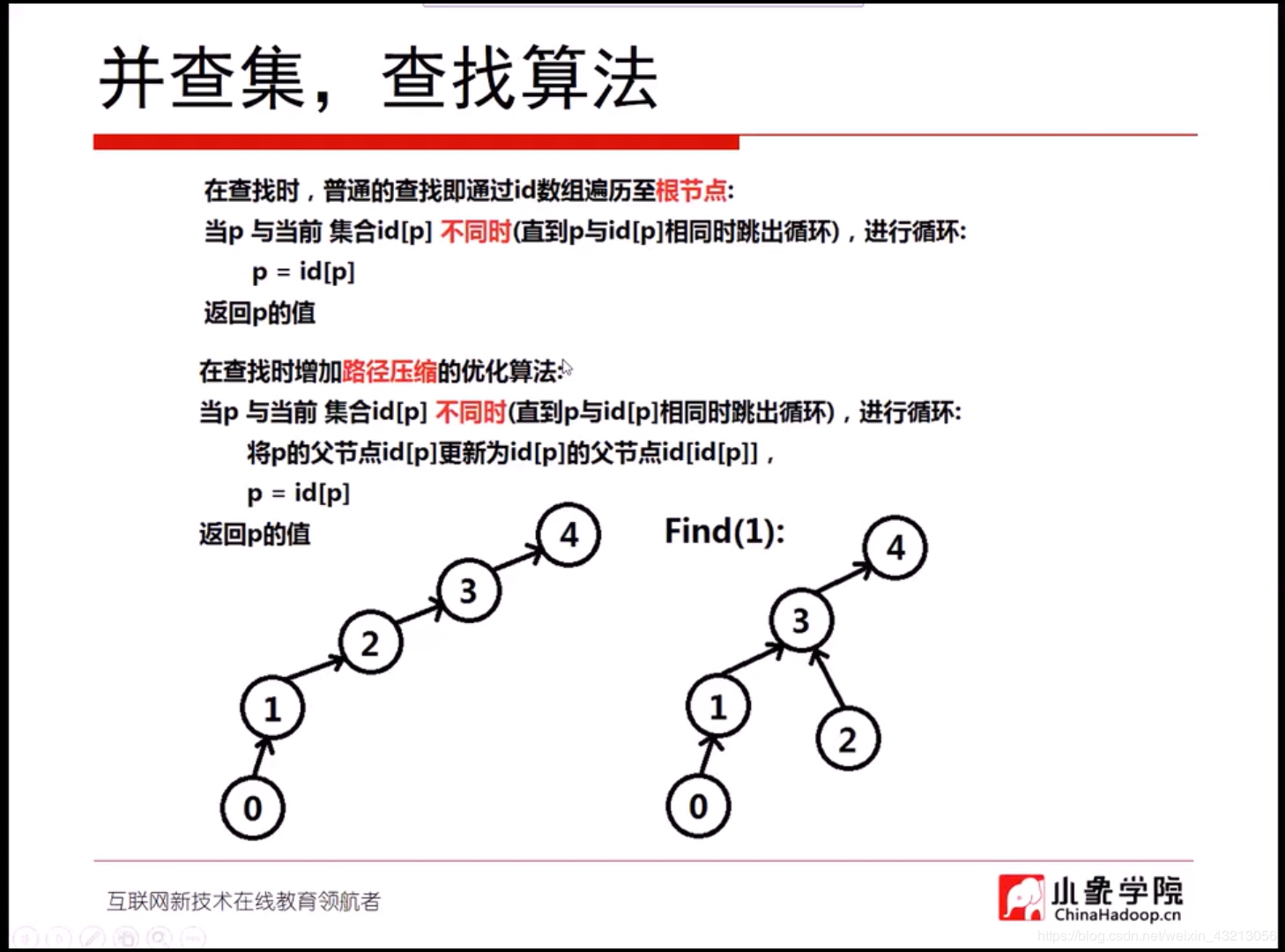
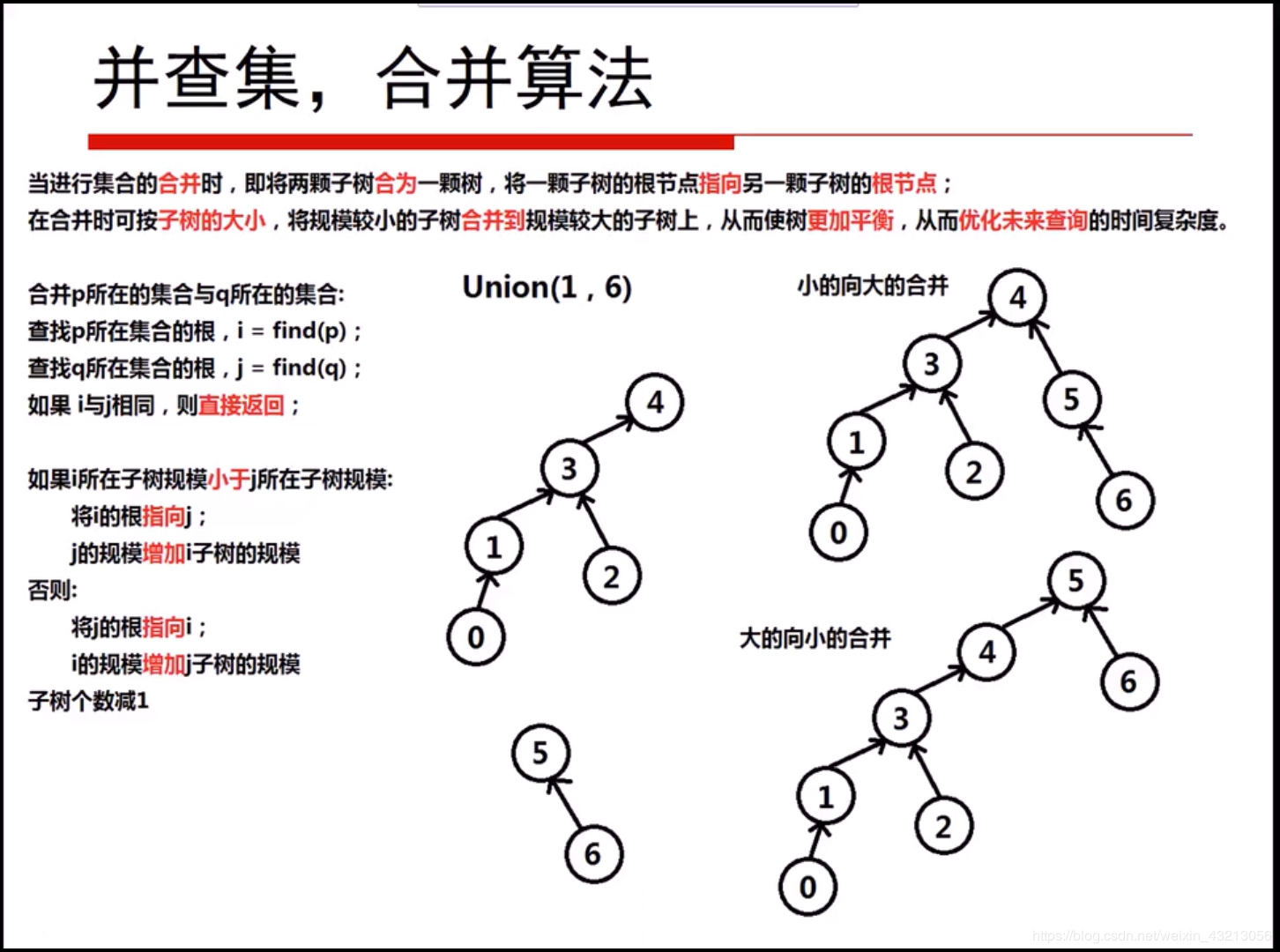
// 并查集的实现
#include <stdio.h>
#include <vector>
#include <string>
// // 方法一:深度搜索算法
// class Solution{
// public:
// int findCircleNum(std::vector<std::vector<int>> &M){
// std::vector<int> visit(M.size(), 0);
// int count = 0;
// for(int i = 0; i < M.size(); i++){
// if(visit[i] == 0){
// DFS_graph(i, M, visit);
// count++;
// }
// }
// return count;
// }
// private:
// void DFS_graph(int u, std::vector<std::vector<int>> &graph, std::vector<int> &visit){
// visit[u] = 1;
// for(int i = 0; i < graph[u].size(); i++) {
// if (visit[i] == 0 && graph[u][i] == 1) {
// DFS_graph(i, graph, visit);
// }
// }
// }
// };
// // 数组实现并查集
// class DisjoinSet{
// public:
// DisjoinSet(int n){
// for(int i = 0; i < n; i++){
// _id.push_back(i);
// }
// }
// int find(int p){
// return _id[p];
// }
// void union_(int p, int q){ // 合并 O(n)
// int pid = find(p);
// int qid = find(q);
// if(pid == qid){
// return;
// }
// for(int i = 0; i < _id.size(); i++){
// if(_id[i] == pid){
// _id[i] = qid;
// }
// }
// }
// void print_set(){
// printf("元素:");
// for(int i = 0; i < _id.size(); i++){
// printf("%d ", i);
// }
// printf("\n");
// printf("集合: ");
// for(int i = 0; i < _id.size(); i++){
// printf("%d ", _id[i]);
// }
// printf("\n");
// }
// private:
// std::vector<int> _id;
// };
// 森林实现并查集
class DisjoinSet {
public:
DisjoinSet(int n) {
for (int i = 0; i < n; i++) {
_id.push_back(i);
_size.push_back(1);
}
_count = n;
}
int find(int p) {
while (p != _id[p]) {
_id[p] = _id[_id[p]]; // 跳着查询
p = _id[p];
}
return p;
}
// 优化: 讲规模较小的子树合并到规模较大的子树
void union_(int p, int q) { // 合并:将一课子树的根节点指向另一棵子树的根节点
int i = find(p);
int j = find(q);
if (i == j) {
return;
}
if (_size[i] < _size[j]) {
_id[i] = j;
_size[j] += _size[i];
}
else {
_id[j] = i;
_size[i] += _size[j];
}
_count--;
}
void print_set() {
printf("元素:");
for (int i = 0; i < _id.size(); i++) {
printf("%d ", i);
}
printf("\n");
printf("集合: ");
for (int i = 0; i < _id.size(); i++) {
printf("%d ", _id[i]);
}
printf("\n");
}
private:
std::vector<int> _id; // 存储的是根节点
std::vector<int> _size; // 子树的规模
int _count; // 朋友圈个数
};
int main() {
DisjoinSet disjoint_set(8);
disjoint_set.print_set();
printf("union(0, 5):\n");
disjoint_set.union_(0, 5);
disjoint_set.print_set();
printf("Find(0) = %d, Find(5) = %d\n", disjoint_set.find(0), disjoint_set.find(5));
printf("Find(2) = %d, Find(5) = %d\n", disjoint_set.find(2), disjoint_set.find(5));
disjoint_set.union_(2, 4);
disjoint_set.print_set();
disjoint_set.union_(0, 4);
disjoint_set.print_set();
printf("Find(2) = %d, Find(5) = %d\n", disjoint_set.find(2), disjoint_set.find(5));
return 0;
}
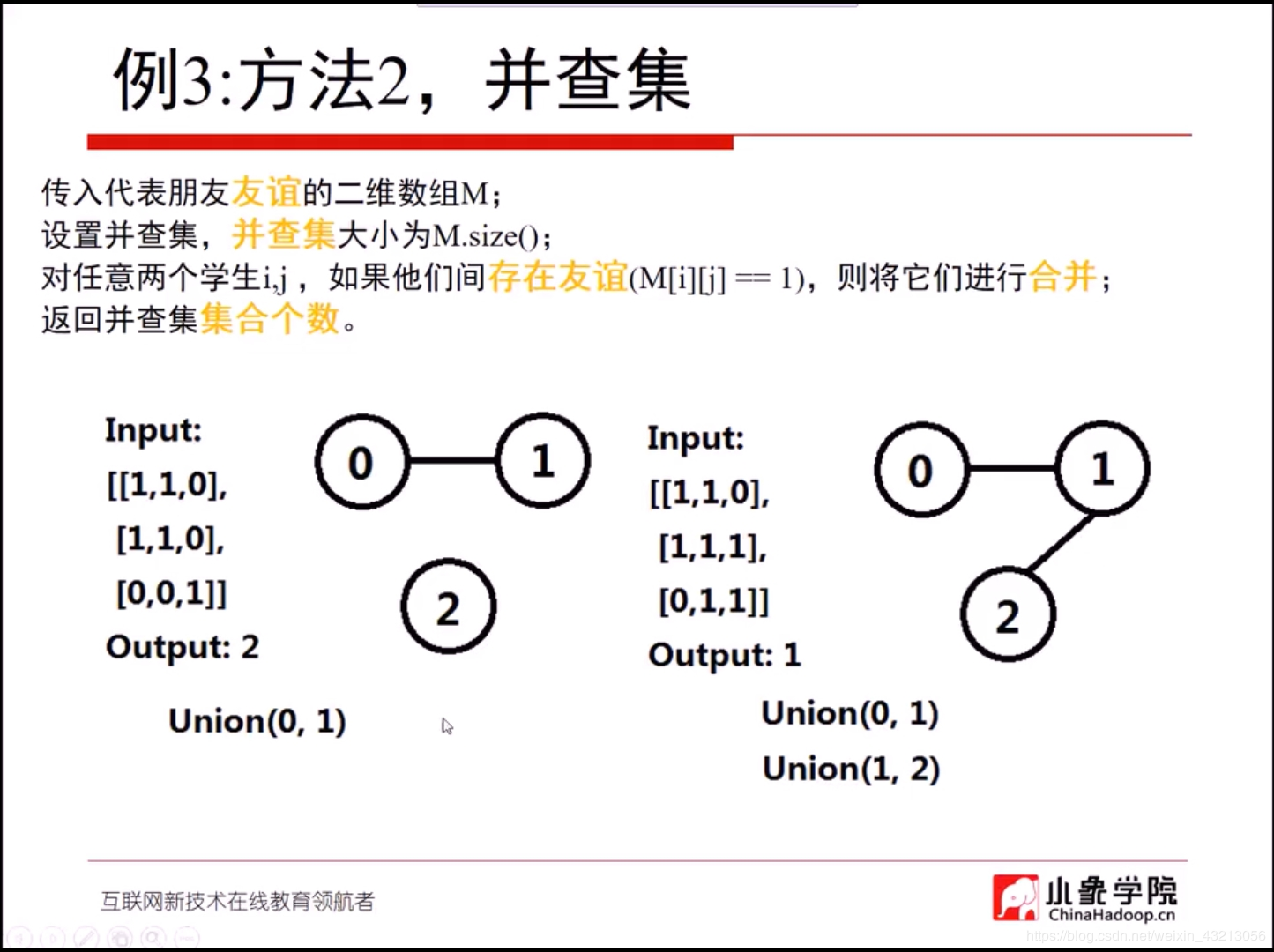
/**
There are N students in a class. Some of them are friends, while some are not.
Their friendship is transitive in nature. For example, if A is a direct friend
of B, and B is a direct friend of C, then A is an indirect friend of C. And we
defined a friend circle is a group of students who are direct or indirect friends.
Given a N*N matrix M representing the friend relationship between students in the
class. If M[i][j] = 1, then the ith and jth students are direct friends with each
other, otherwise not. And you have to output the total number of friend circles
among all the students.
*/
#include <stdio.h>
#include <vector>
#include <string>
// // 方法一:深度搜索算法
// class Solution{
// public:
// int findCircleNum(std::vector<std::vector<int>> &M){
// std::vector<int> visit(M.size(), 0);
// int count = 0;
// for(int i = 0; i < M.size(); i++){
// if(visit[i] == 0){
// DFS_graph(i, M, visit);
// count++;
// }
// }
// return count;
// }
// private:
// void DFS_graph(int u, std::vector<std::vector<int>> &graph, std::vector<int> &visit){
// visit[u] = 1;
// for(int i = 0; i < graph[u].size(); i++) {
// if (visit[i] == 0 && graph[u][i] == 1) {
// DFS_graph(i, graph, visit);
// }
// }
// }
// };
class DisjoinSet {
public:
DisjoinSet(int n) {
for (int i = 0; i < n; i++) {
_id.push_back(i);
_size.push_back(1);
}
_count = n;
}
int find(int p) {
while (p != _id[p]) {
_id[p] = _id[_id[p]]; // 跳着查询
p = _id[p];
}
return p;
}
// 优化: 讲规模较小的子树合并到规模较大的子树
void union_(int p, int q) { // 合并:将一课子树的根节点指向另一棵子树的根节点
int i = find(p);
int j = find(q);
if (i == j) {
return;
}
if (_size[i] < _size[j]) {
_id[i] = j;
_size[j] += _size[i];
}
else {
_id[j] = i;
_size[i] += _size[j];
}
_count--;
}
void print_set() {
printf("元素:");
for (int i = 0; i < _id.size(); i++) {
printf("%d ", i);
}
printf("\n");
printf("集合: ");
for (int i = 0; i < _id.size(); i++) {
printf("%d ", _id[i]);
}
printf("\n");
}
int count(){
return _count;
}
private:
std::vector<int> _id; // 存储的是根节点
std::vector<int> _size; // 子树的规模
int _count; // 朋友圈个数
};
class Solution{
public:
int findCircleNum(std::vector<std::vector<int>> &M){
DisjoinSet disjoint_set(M.size());
for(int i = 0; i < M.size(); i++){
for(int j = i + 1; j < M.size(); j++){
if(M[i][j]){
disjoint_set.union_(i, j);
}
}
}
return disjoint_set.count();
}
};
int main(){
int test[][3] = {{1, 1, 0}, {1, 1, 0}, {0, 0, 1}};
std::vector<std::vector<int>> M(3, std::vector<int>(3, 0));
for(int i = 0; i < 3; i++){
for(int j = 0; j < 3; j++){
M[i][j] = test[i][j];
}
}
Solution solve;
printf("%d\n", solve.findCircleNum(M));
return 0;
}
例四:LeetCode307
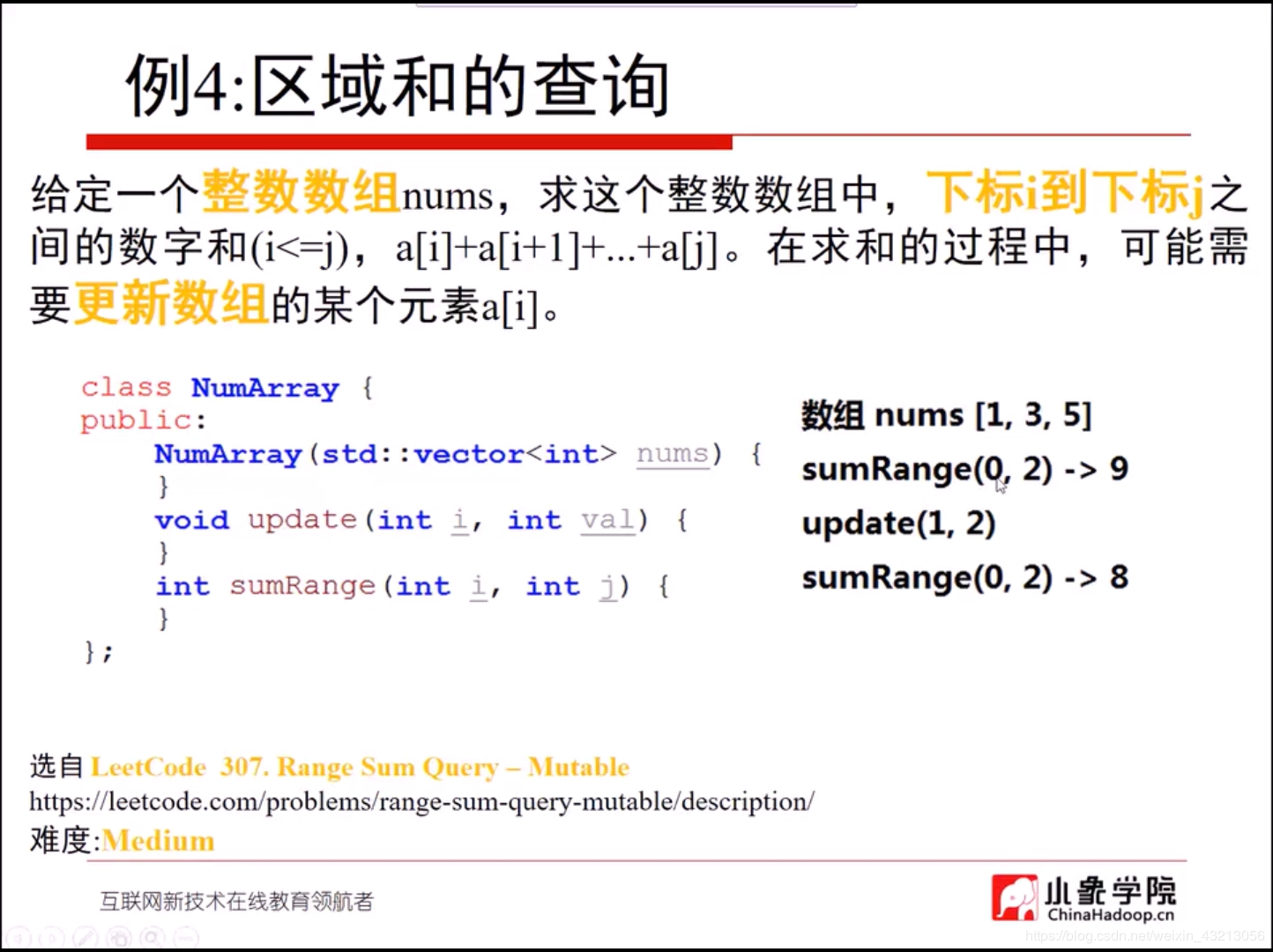
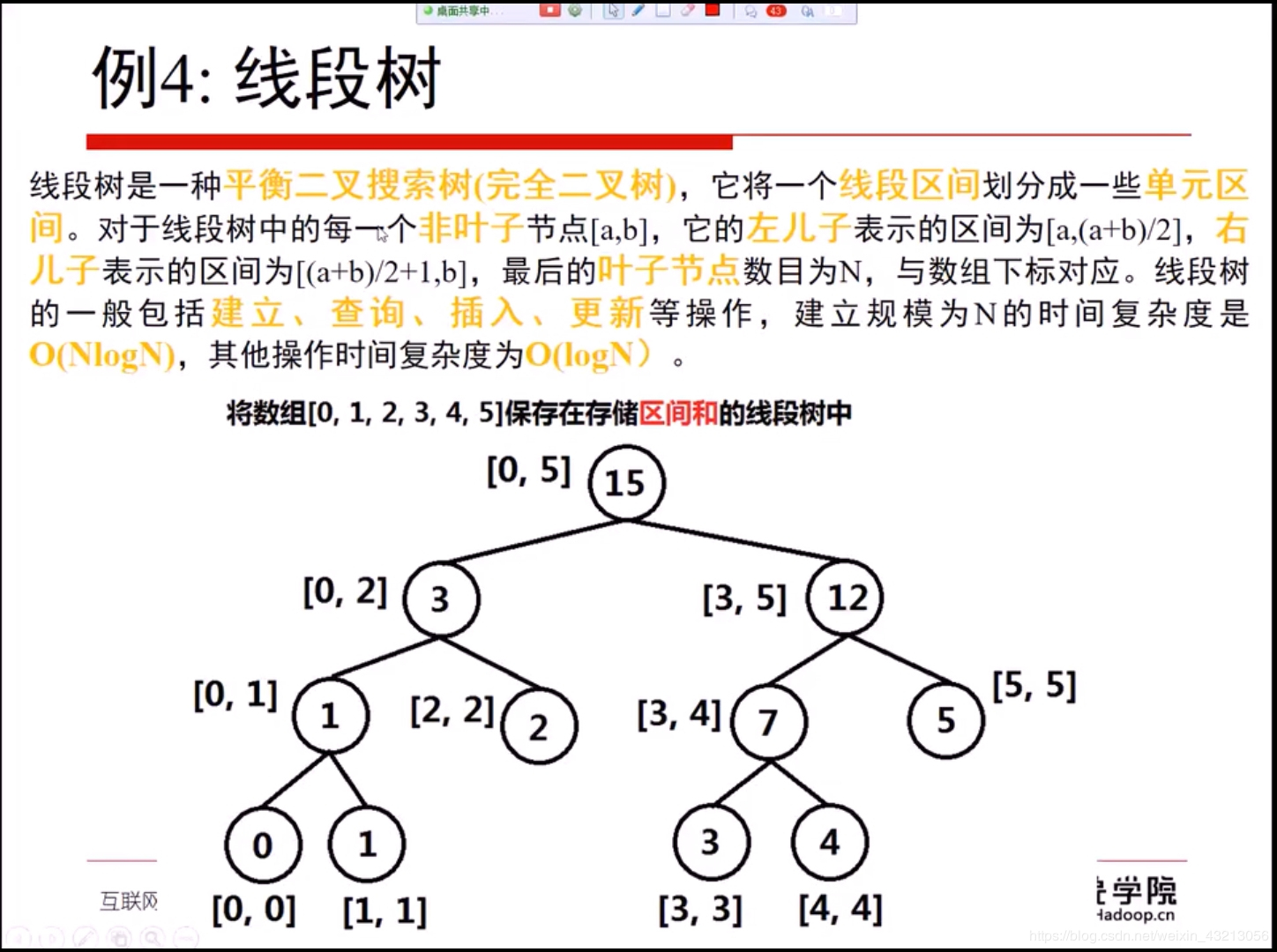

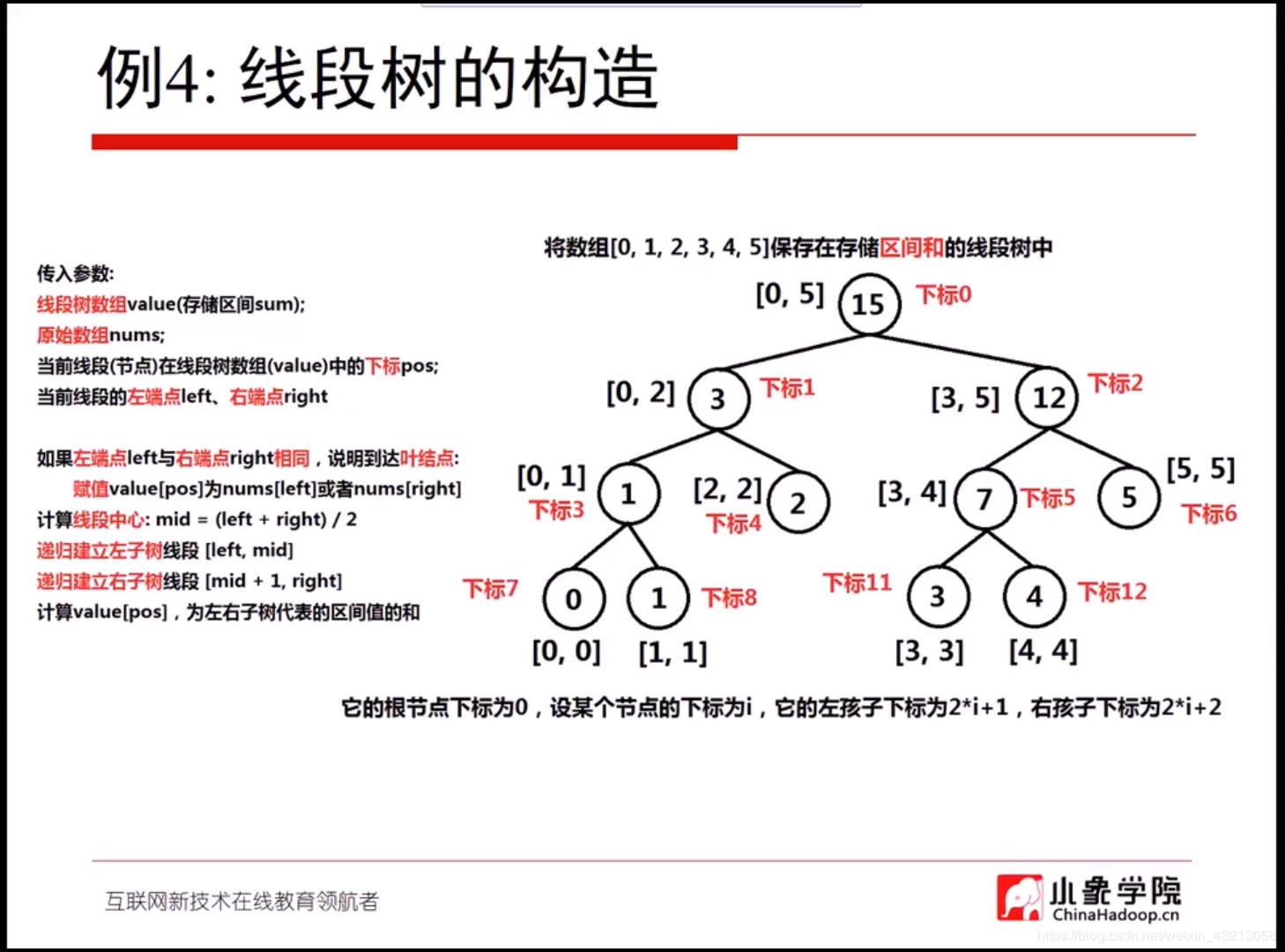
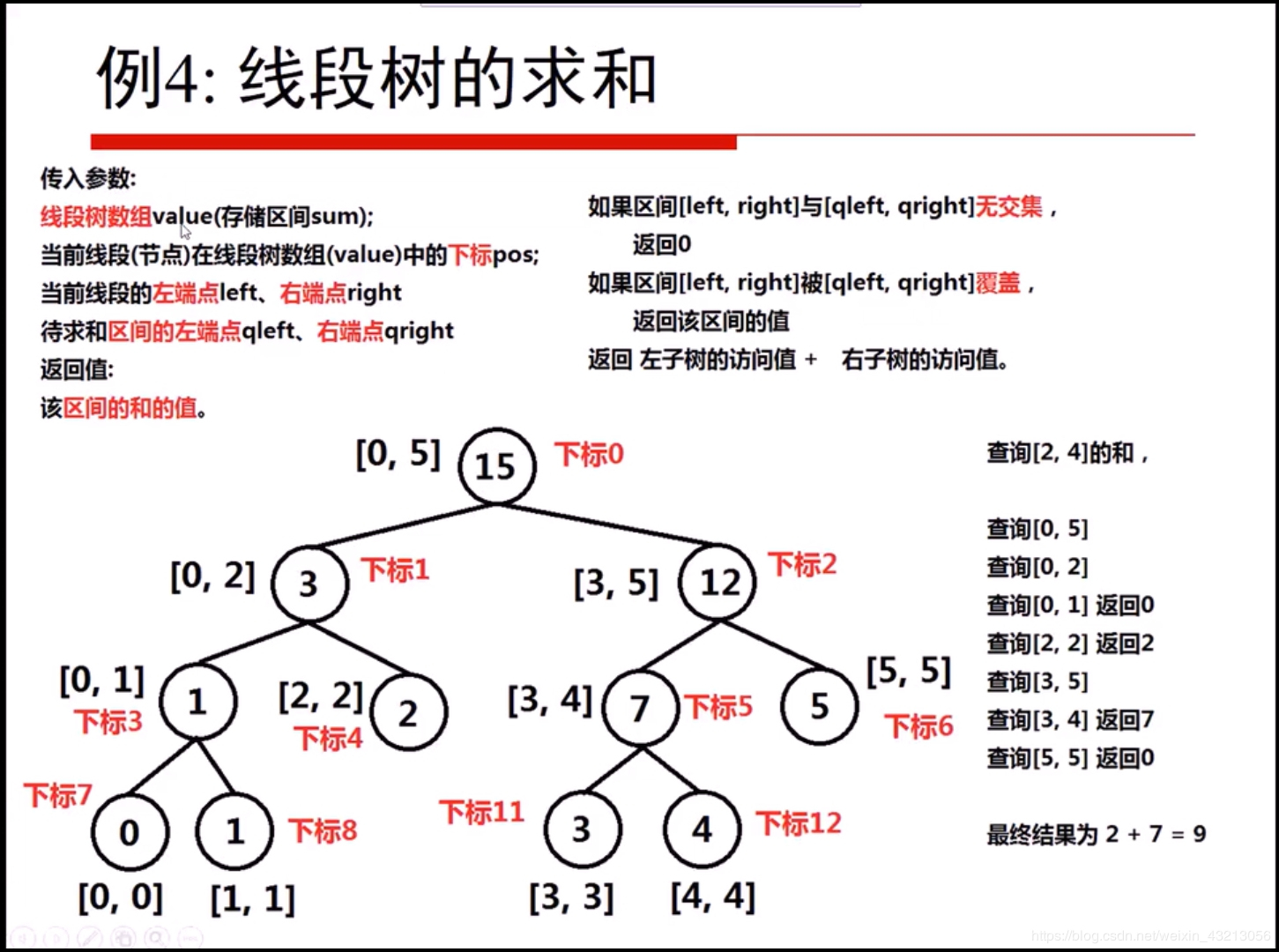
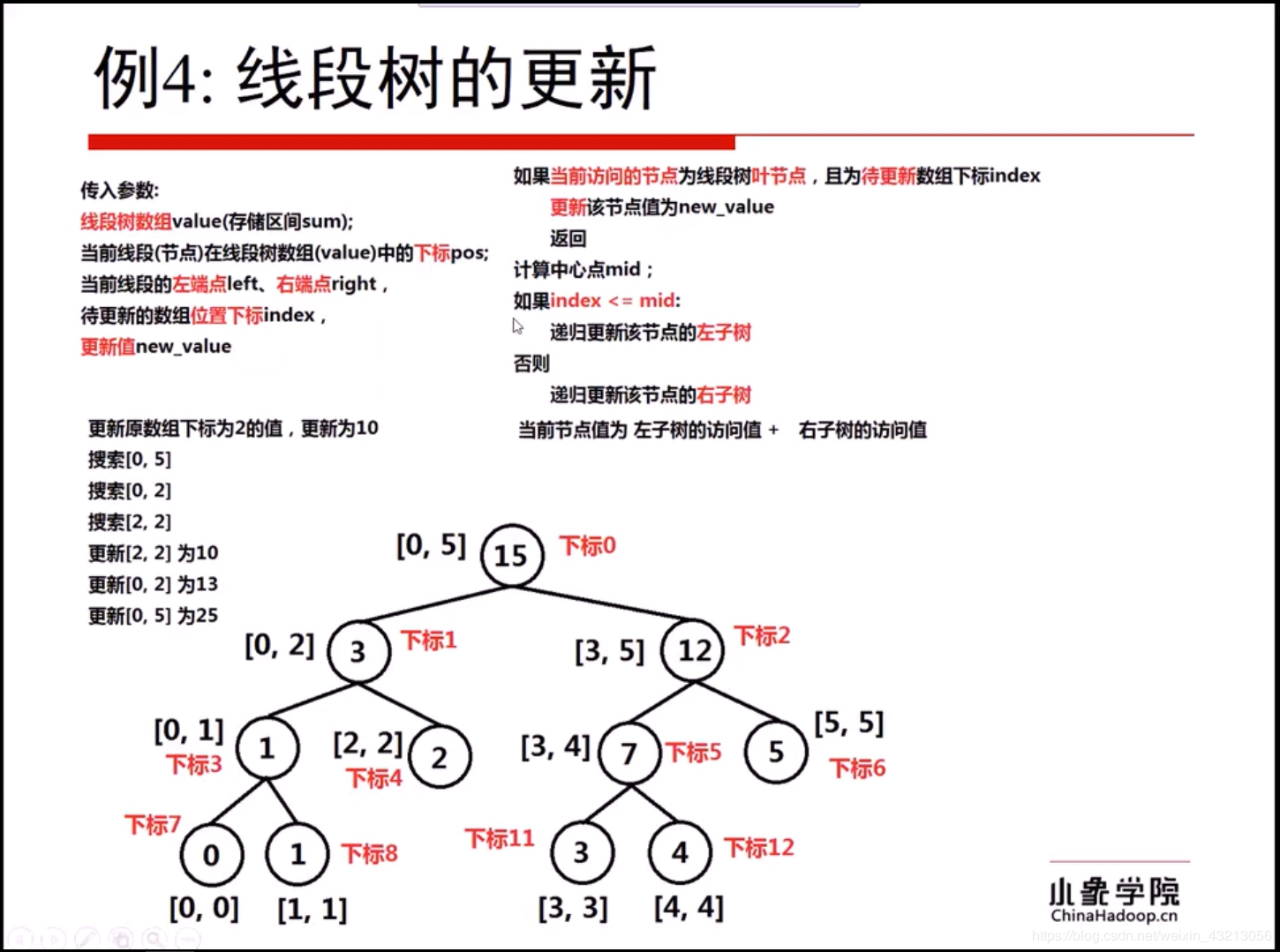
/**
Given an integer array nums, find the sum of the elements between indices i and j (i ≤ j), inclusive.
The update(i, val) function modifies nums by updating the element at index i to val.
*/
#include <stdio.h>
#include <vector>
class NumArray {
public:
NumArray(std::vector<int> nums) {
if (nums.size() == 0) {
return;
}
int n = nums.size() * 4; // 一般线段树数组的大小是原数组大小长度的4倍
for (int i = 0; i < n; i++) {
_value.push_back(0);
}
build_segment_tree(_value, nums, 0, 0, nums.size() - 1);
_right_end = nums.size() - 1;
}
void update(int i, int val) {
update_segment_tree(_value, 0, 0, _right_end, i, val);
}
int sumRange(int i, int j) {
return sum_range_segment_tree(_value, 0, 0, _right_end, i, j);
}
private:
std::vector<int> _value;
int _right_end;
// 建立线段树
void build_segment_tree(std::vector<int>& value, std::vector<int>& nums, int pos, int left, int right) {
if (left == right) {
value[pos] = nums[left];
return;
}
int mid = (left + right) / 2;
build_segment_tree(value, nums, pos * 2 + 1, left, mid);
build_segment_tree(value, nums, pos * 2 + 2, mid + 1, right);
value[pos] = value[pos * 2 + 1] + value[pos * 2 + 2];
}
// 线段树遍历
void print_segment_tree(std::vector<int>& value, int pos, int left, int right, int layer) {
for (int i = 0; i < layer; i++) {
printf("---");
}
printf("[%d %d][%d]: %d\n", left, right, pos, value[pos]);
if (left == right) {
return;
}
int mid = (left + right) / 2;
print_segment_tree(value, pos * 2 + 1, left, mid, layer + 1);
print_segment_tree(value, pos * 2 + 2, mid + 1, right, layer + 1);
}
// 线段树区间求和
int sum_range_segment_tree(std::vector<int>& value, int pos, int left, int right, int qleft, int qright) {
if (qleft > right || qright < left) {
return 0;
}
if (qleft <= left && qright >= right) {
return value[pos];
}
int mid = (left + right) / 2;
return sum_range_segment_tree(value, pos * 2 + 1, left, mid, qleft, qright) +
sum_range_segment_tree(value, pos * 2 + 2, mid + 1, right, qleft, qright);
}
// 线段树更新
void update_segment_tree(std::vector<int>& value, int pos, int left, int right, int index, int new_value) {
if (left == right && left == index) {
value[pos] = new_value;
return;
}
int mid = (left + right) / 2;
if (index <= mid) {
update_segment_tree(value, pos * 2 + 1, left, mid, index, new_value);
}
else {
update_segment_tree(value, pos * 2 + 2, mid + 1, right, index, new_value);
}
value[pos] = value[pos * 2 + 1] + value[pos * 2 + 2];
}
};
int main() {
std::vector<int> nums;
nums.push_back(1);
nums.push_back(3);
nums.push_back(5);
NumArray num_array(nums);
printf("%d\n", num_array.sumRange(0, 2));
num_array.update(1, 2);
printf("%d\n", num_array.sumRange(0, 2));
}
































 本文深入探讨字典树(Trie)与线段树(Segment Tree)的实现细节,包括节点结构、插入、搜索、前缀查询、整体功能、深度优先遍历、获取所有单词、区间求和与更新等核心操作。通过具体代码示例,阐述了如何利用这两种数据结构解决实际问题。
本文深入探讨字典树(Trie)与线段树(Segment Tree)的实现细节,包括节点结构、插入、搜索、前缀查询、整体功能、深度优先遍历、获取所有单词、区间求和与更新等核心操作。通过具体代码示例,阐述了如何利用这两种数据结构解决实际问题。

















 被折叠的 条评论
为什么被折叠?
被折叠的 条评论
为什么被折叠?








